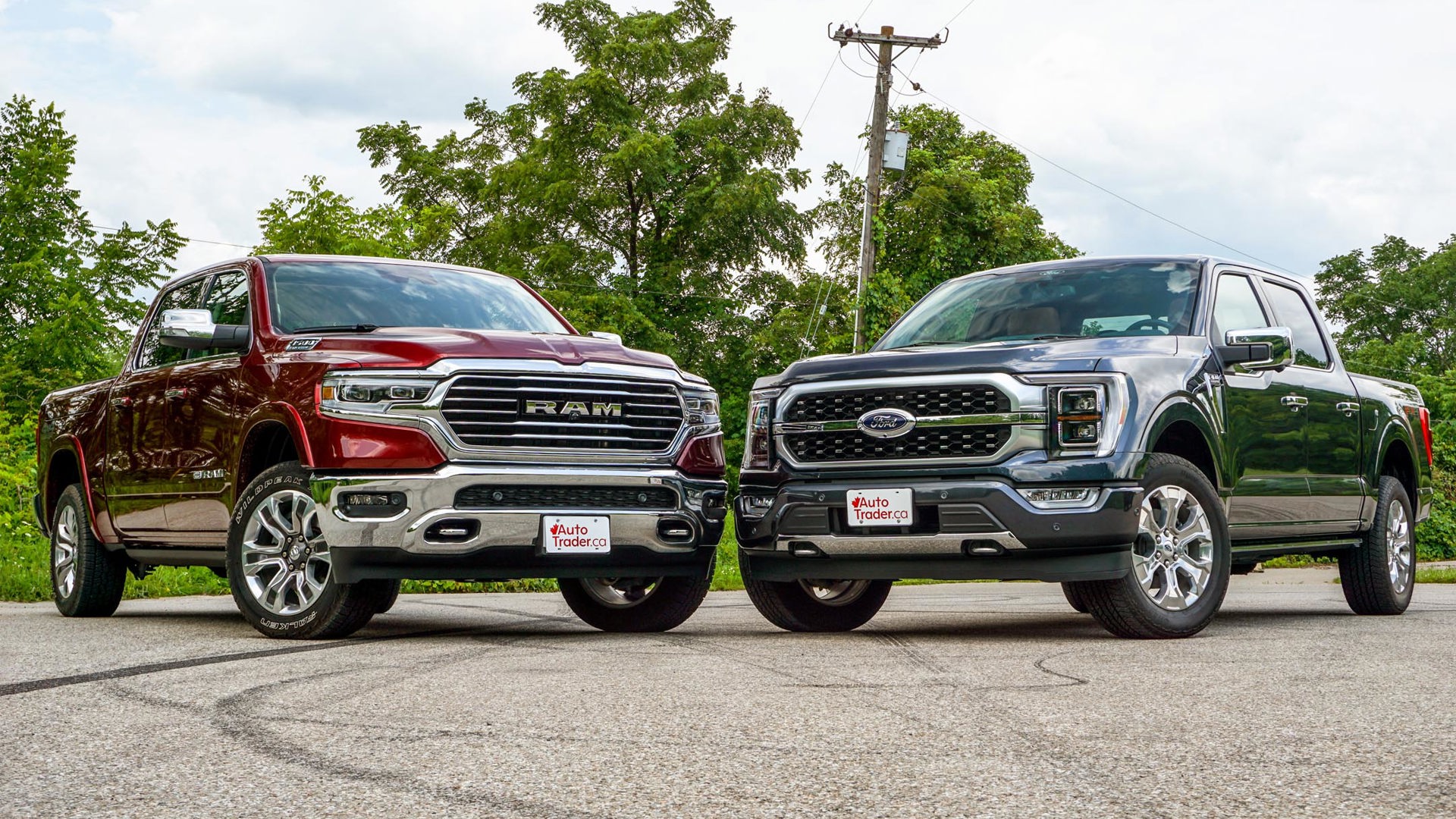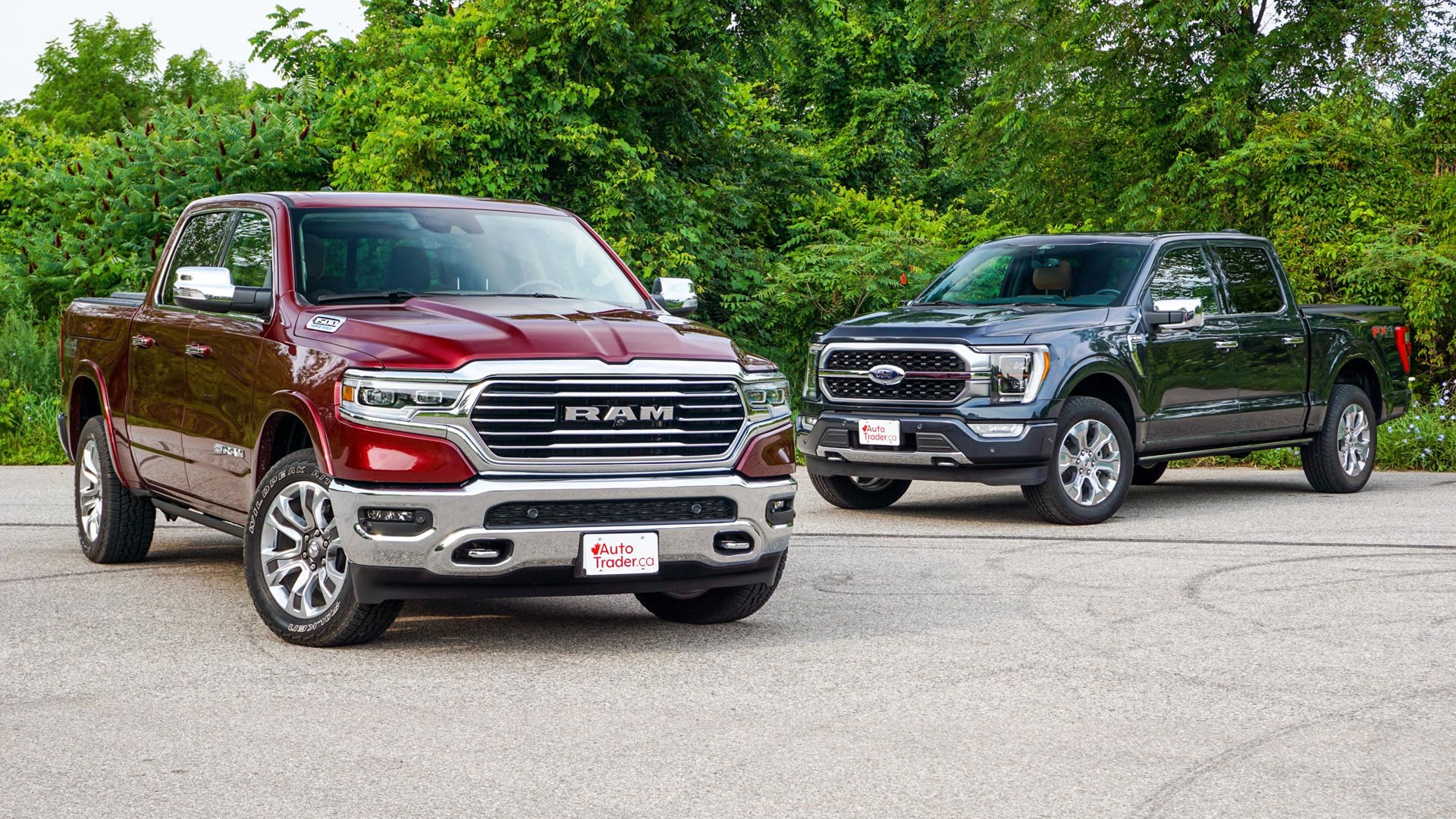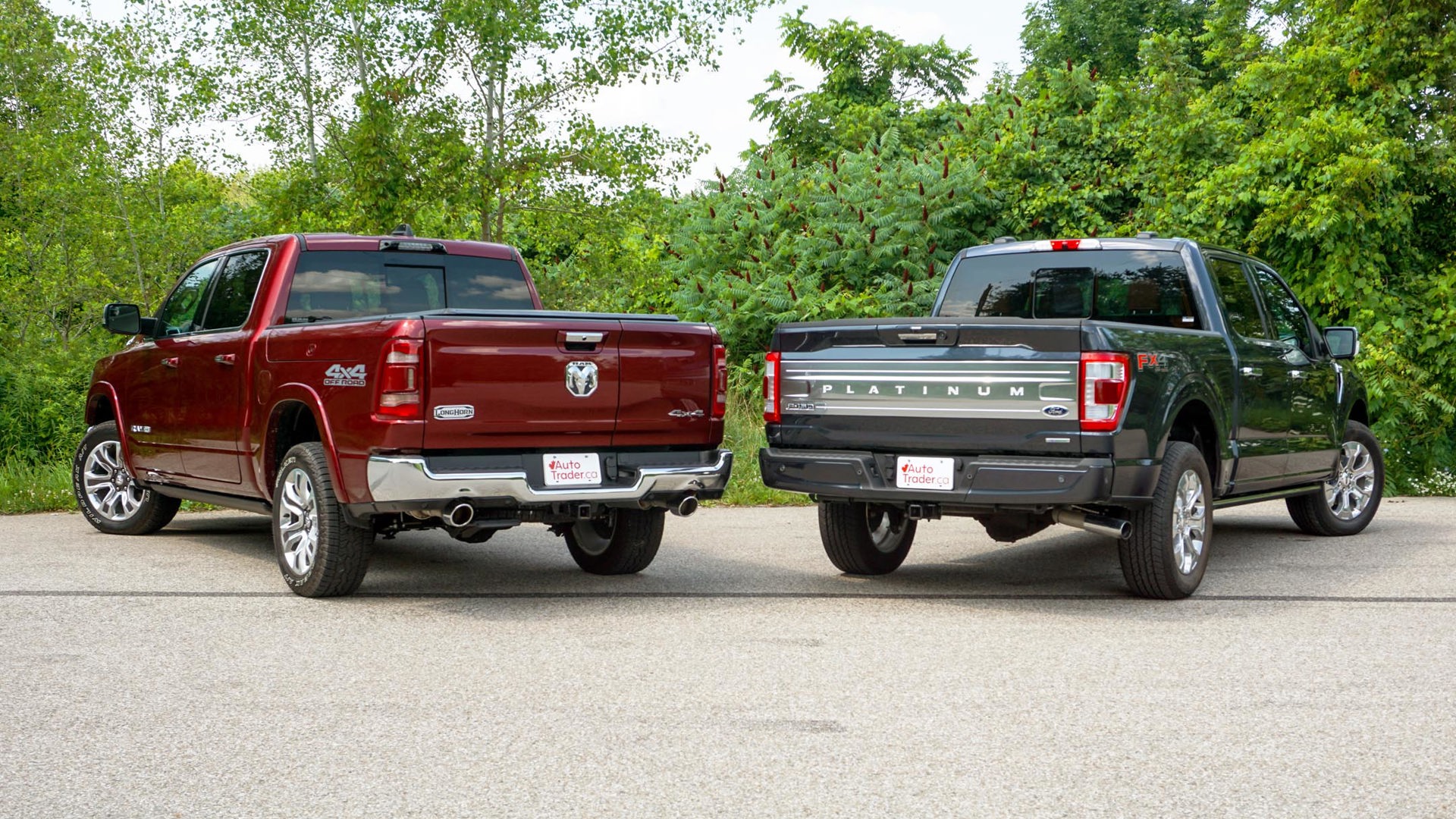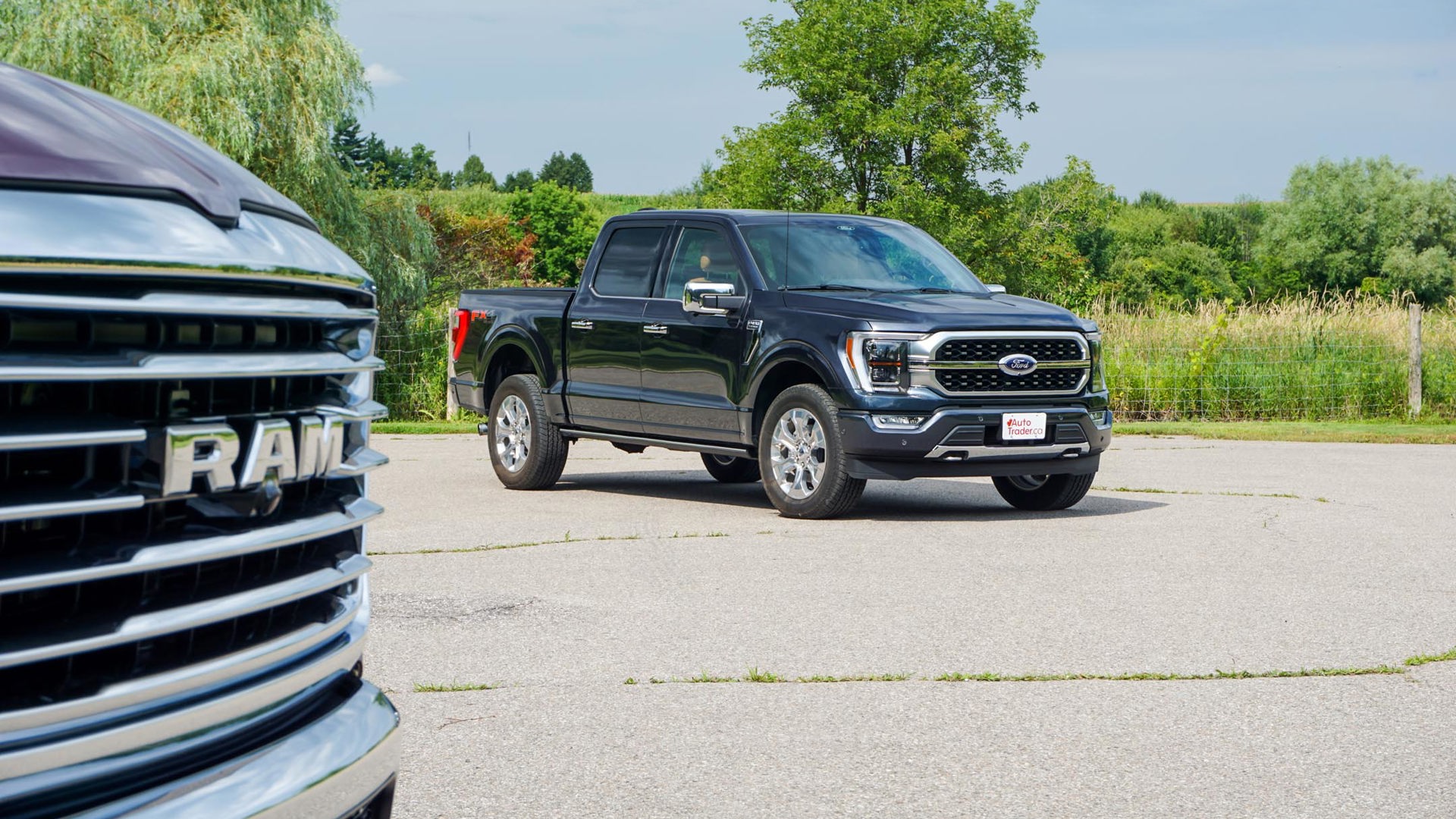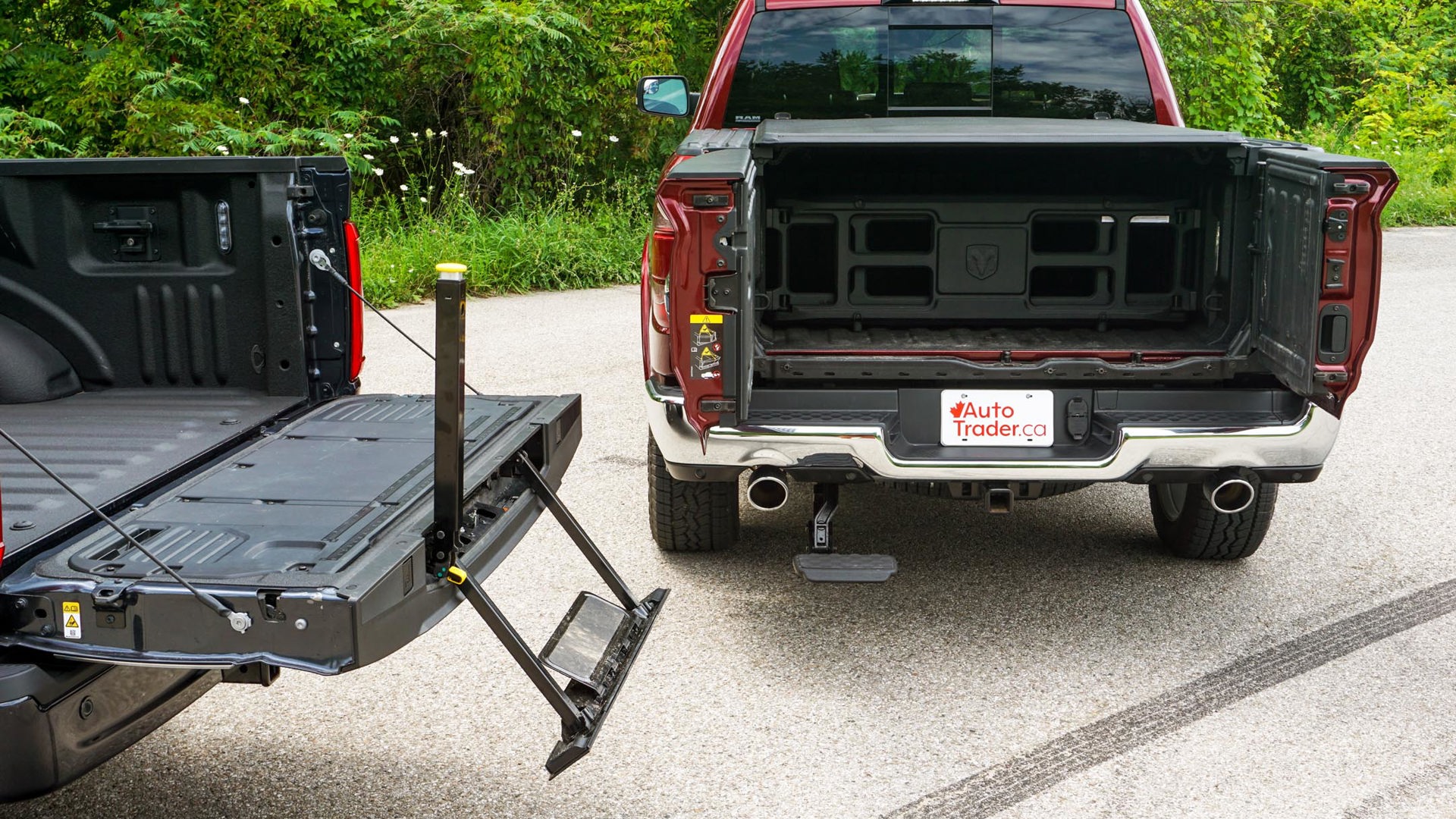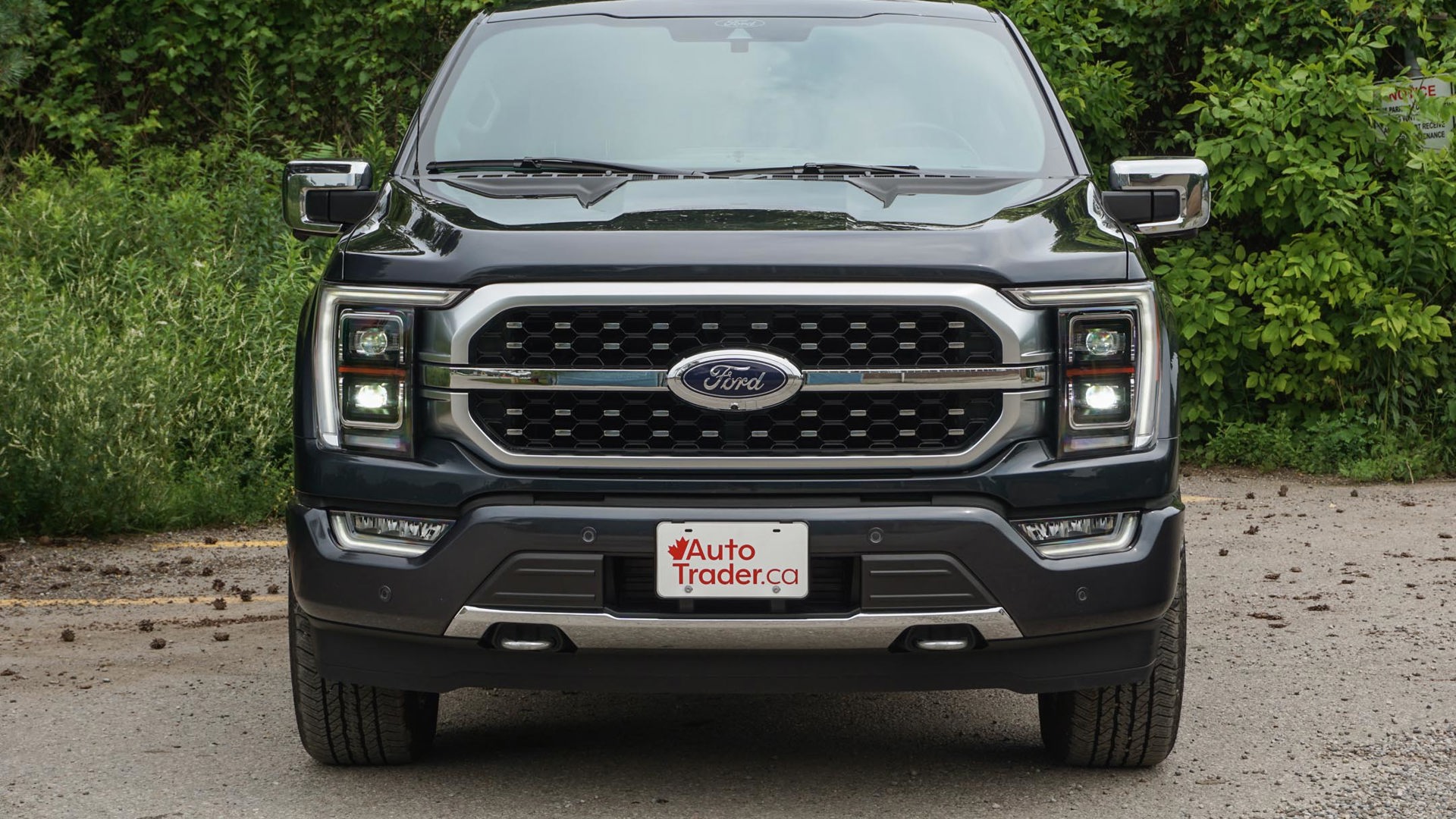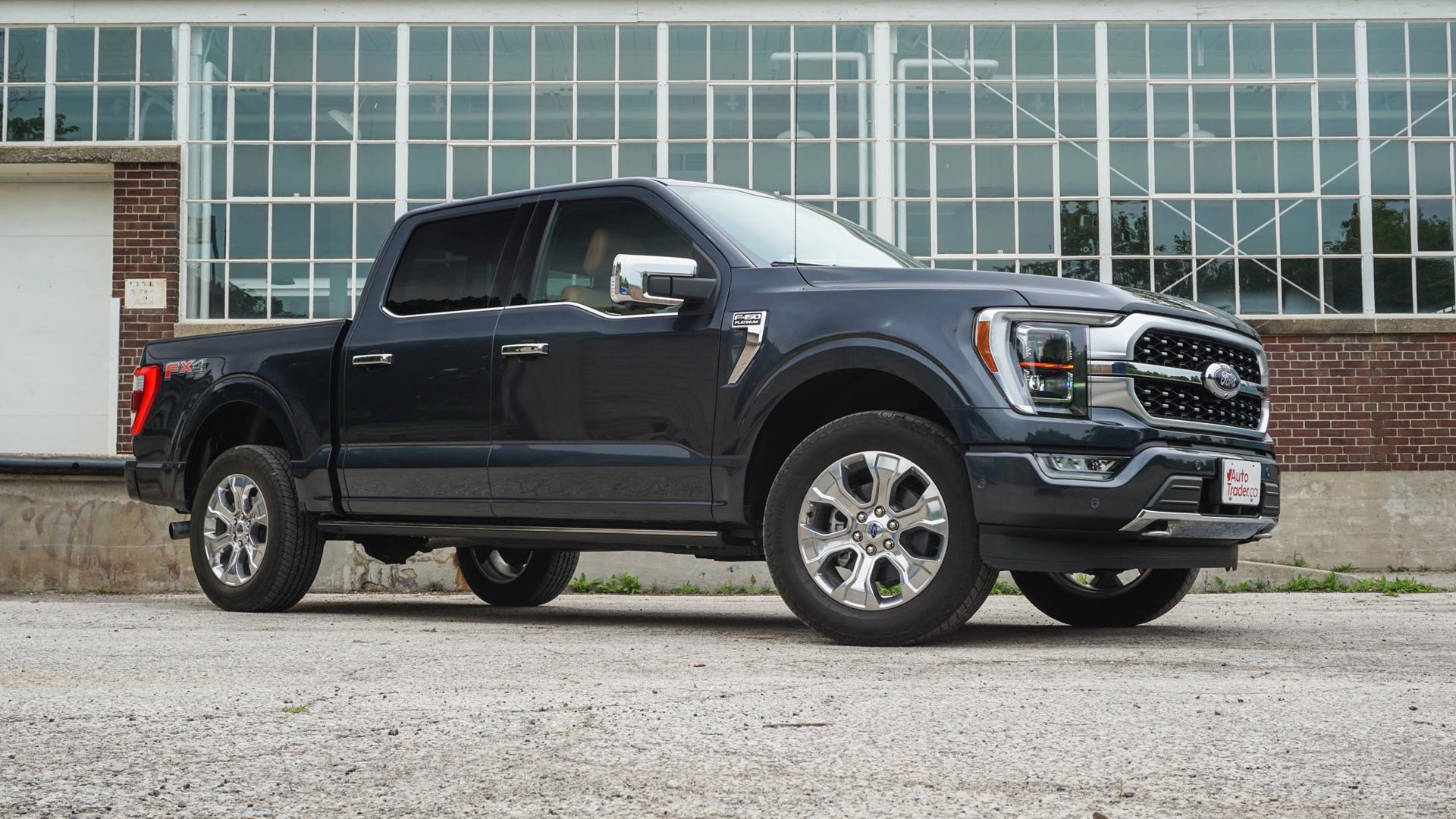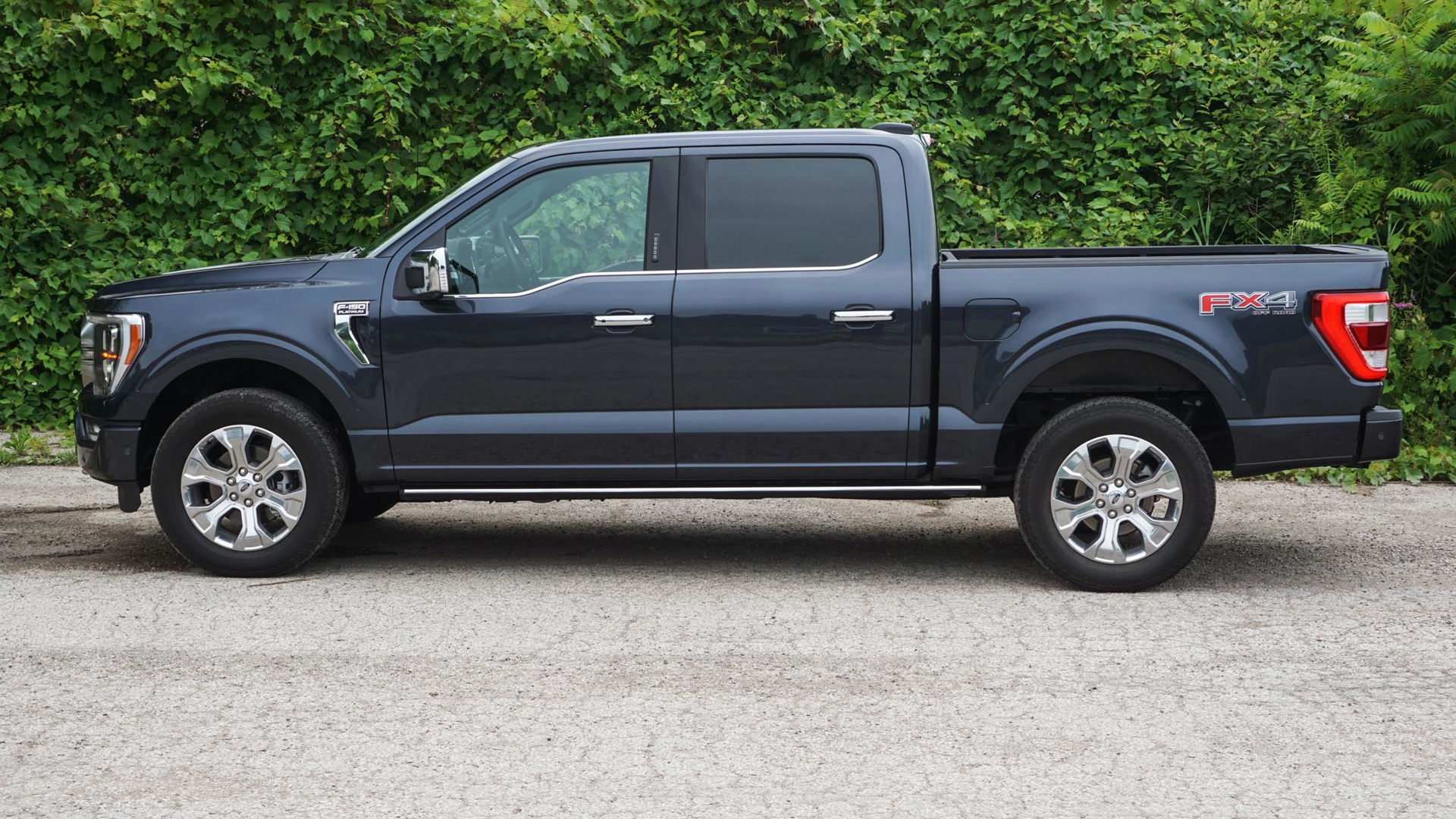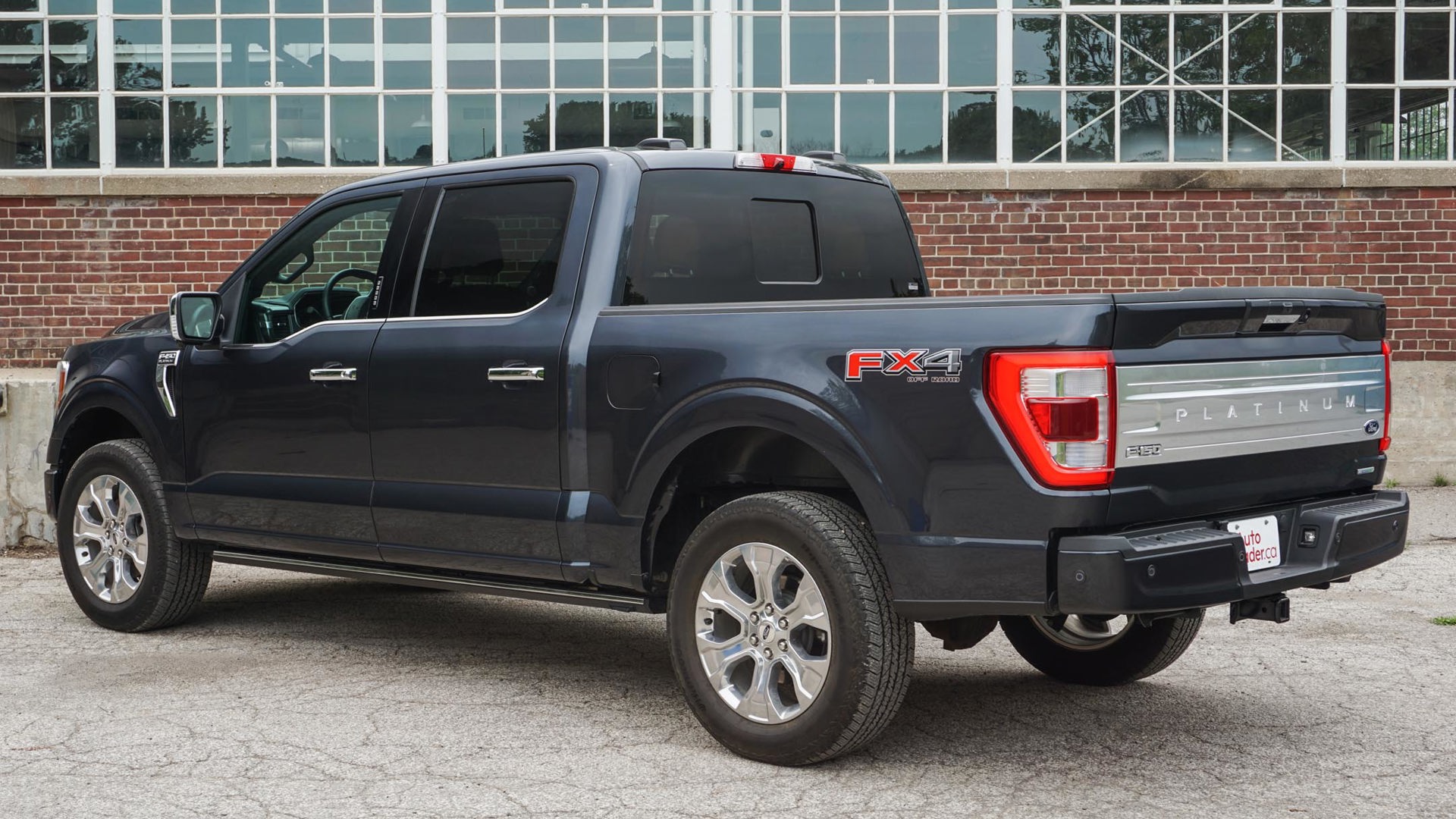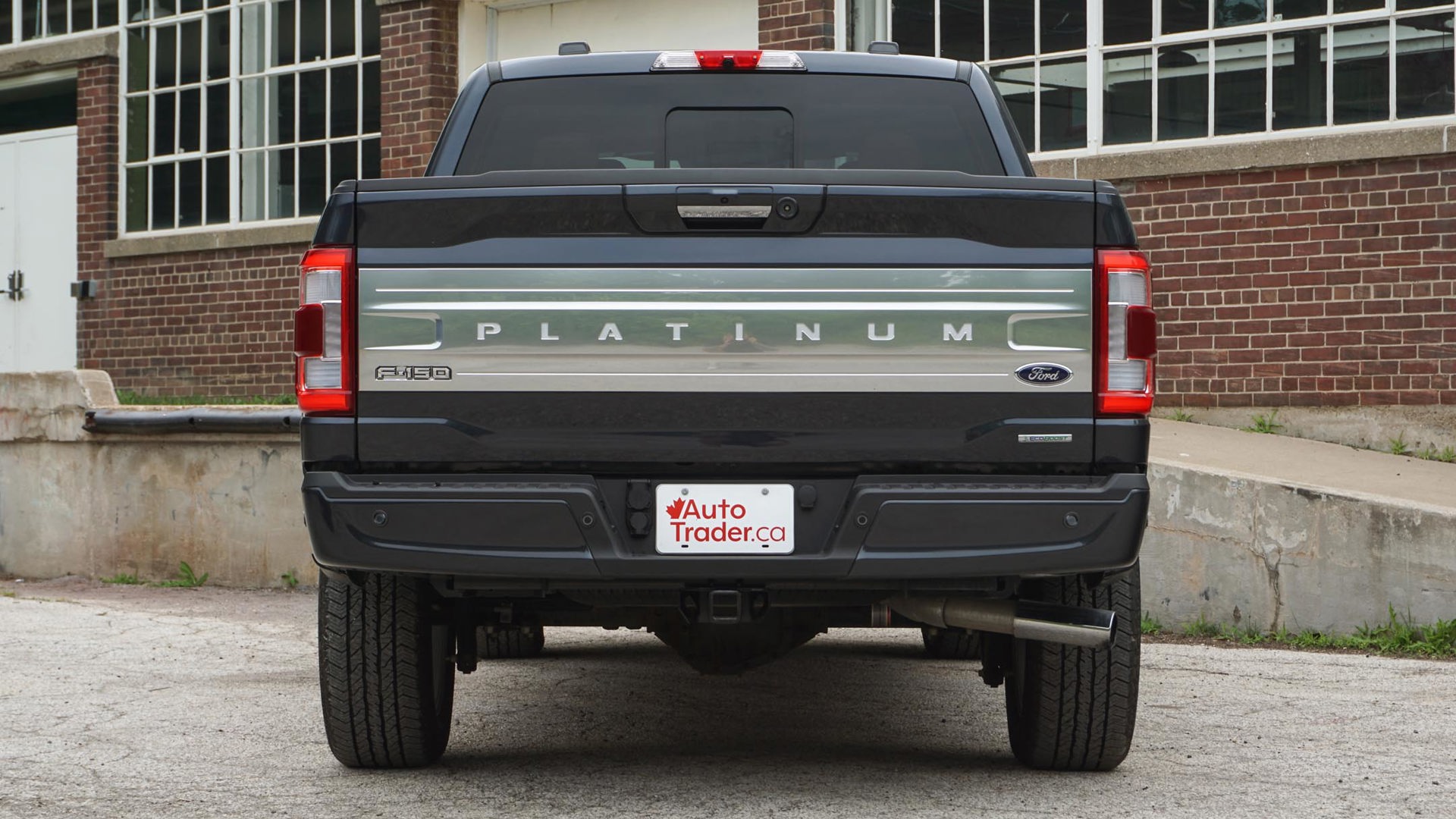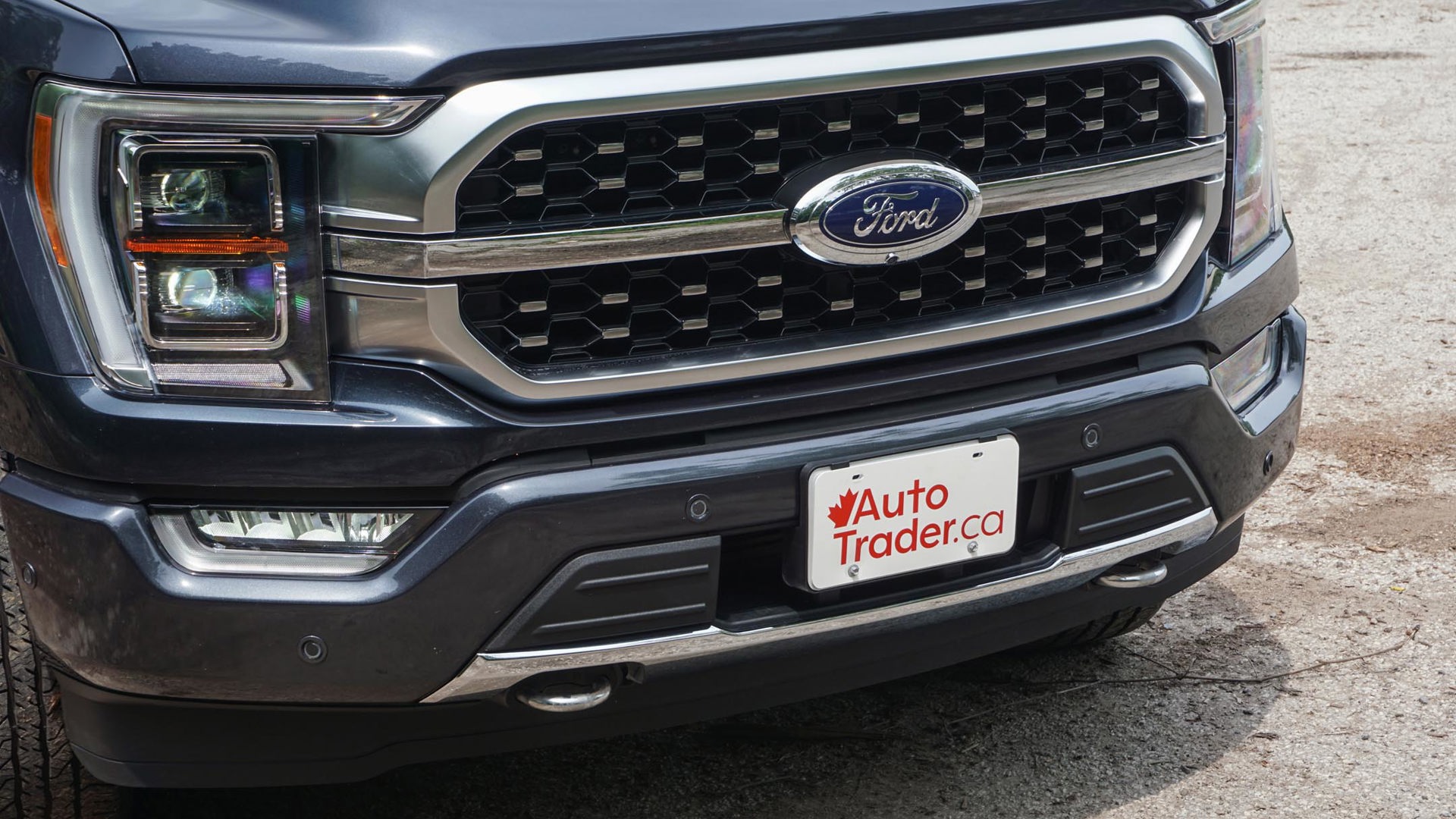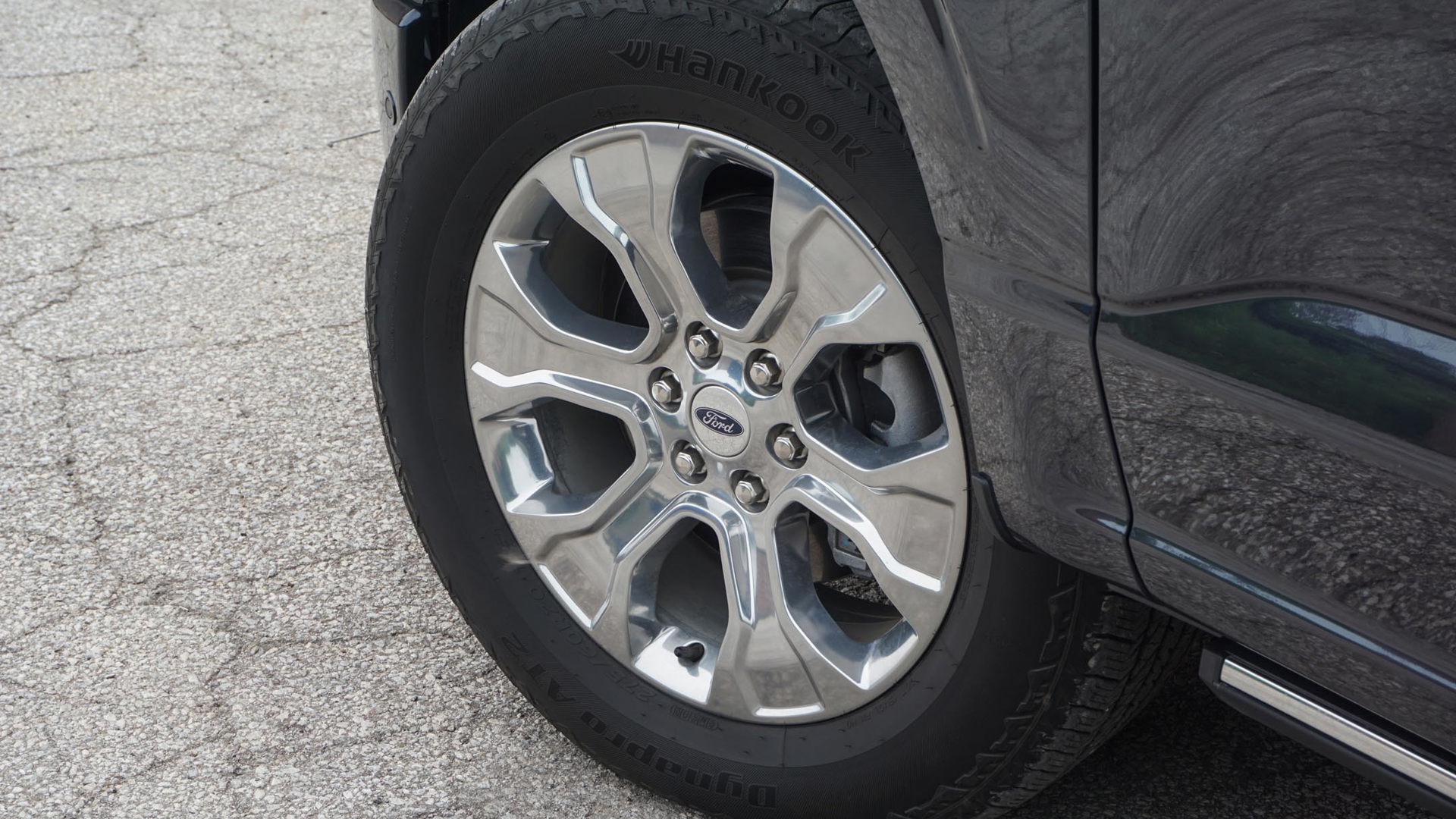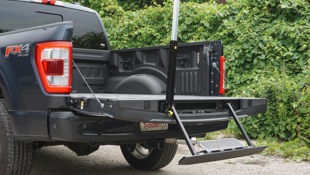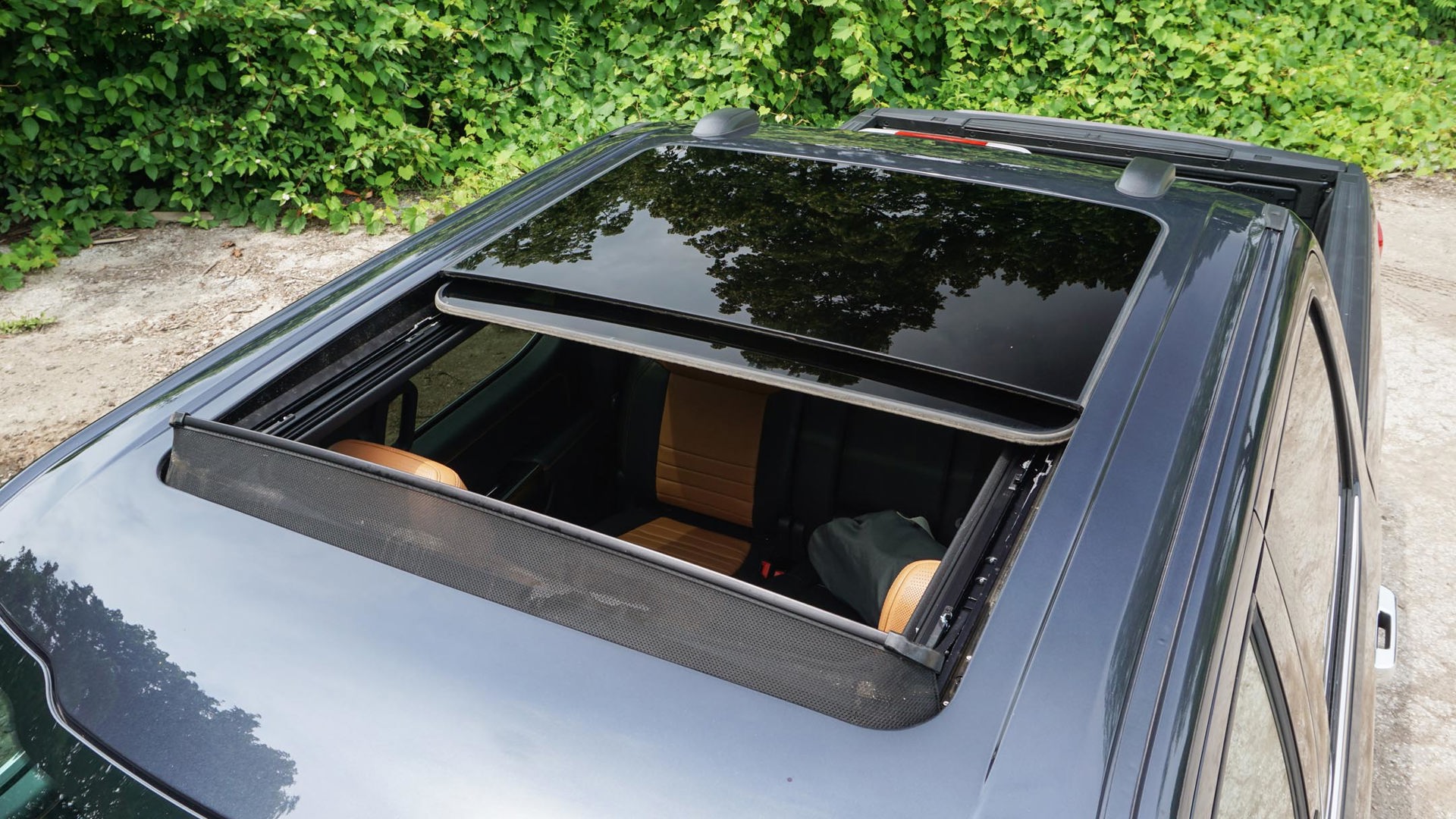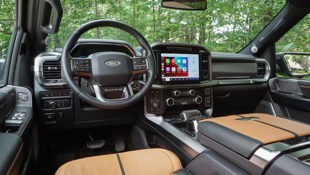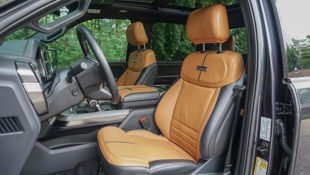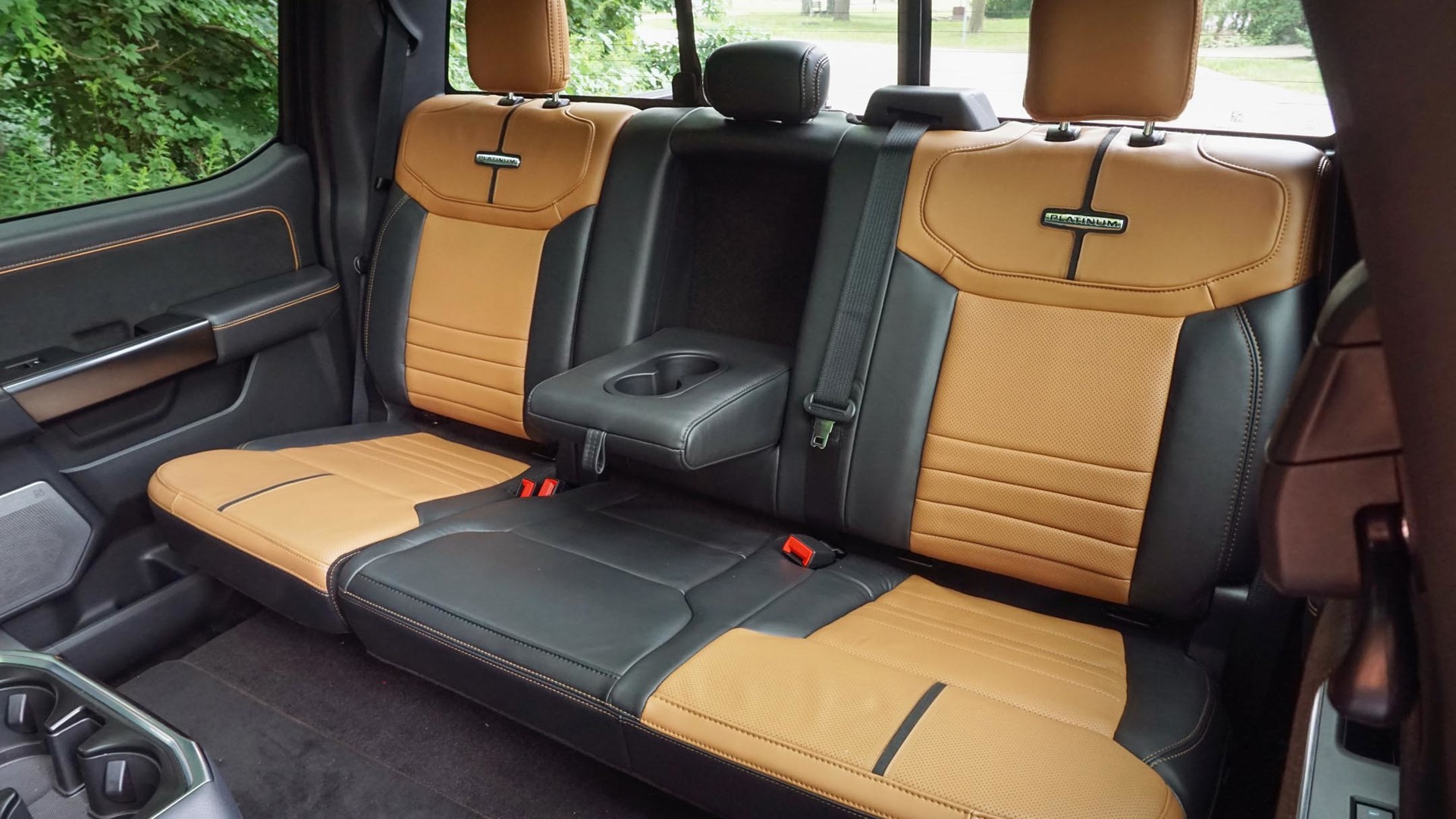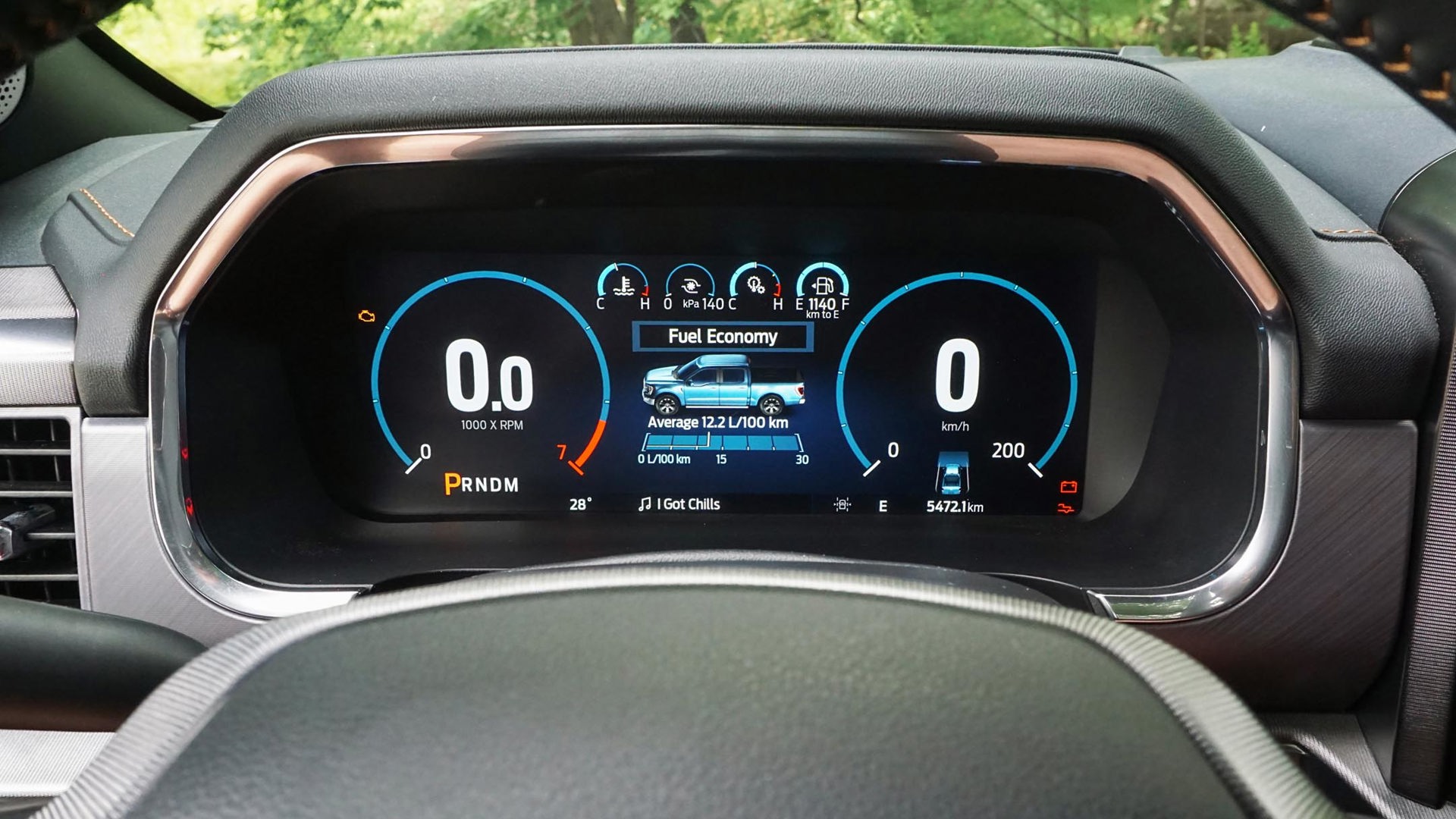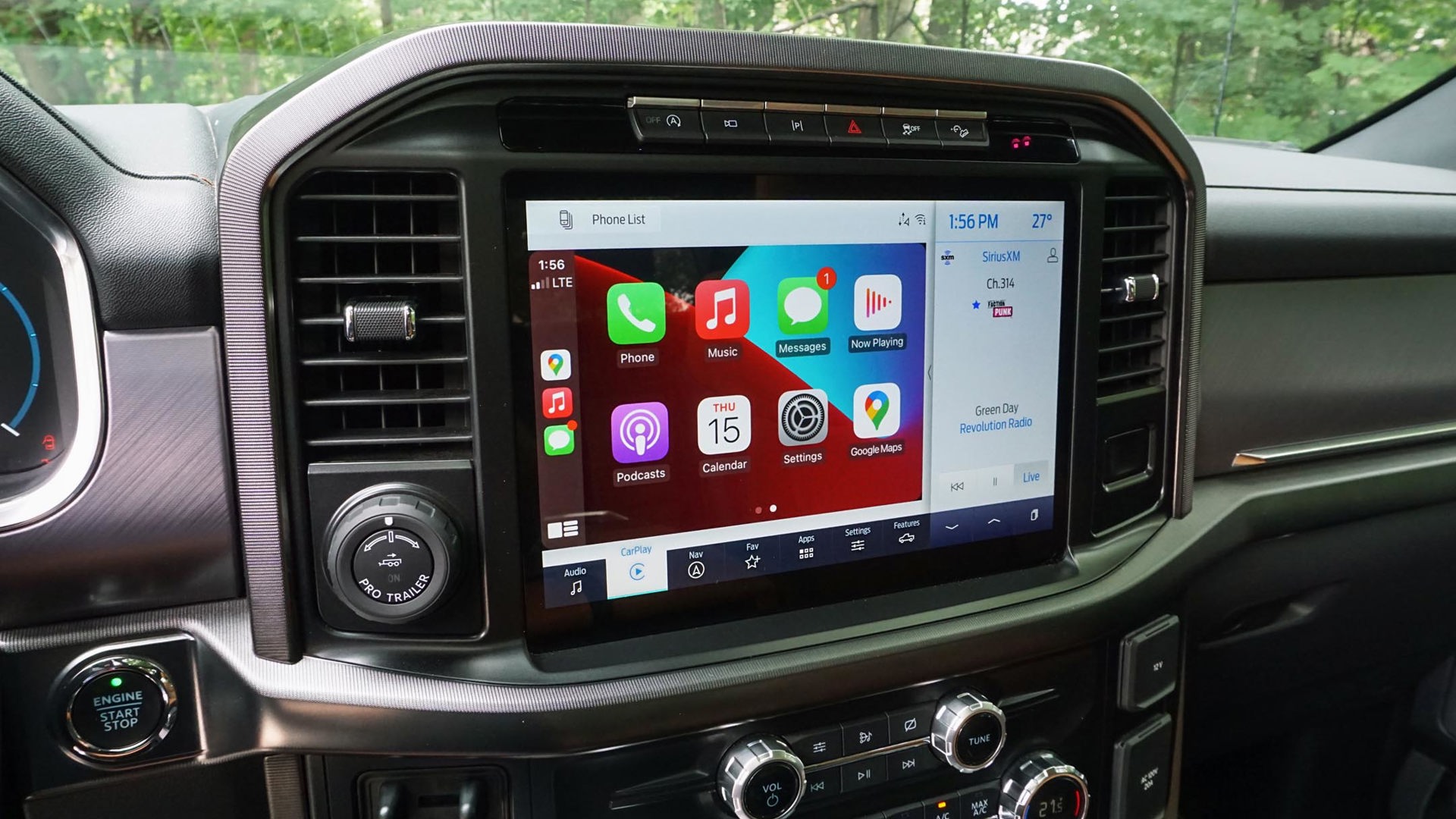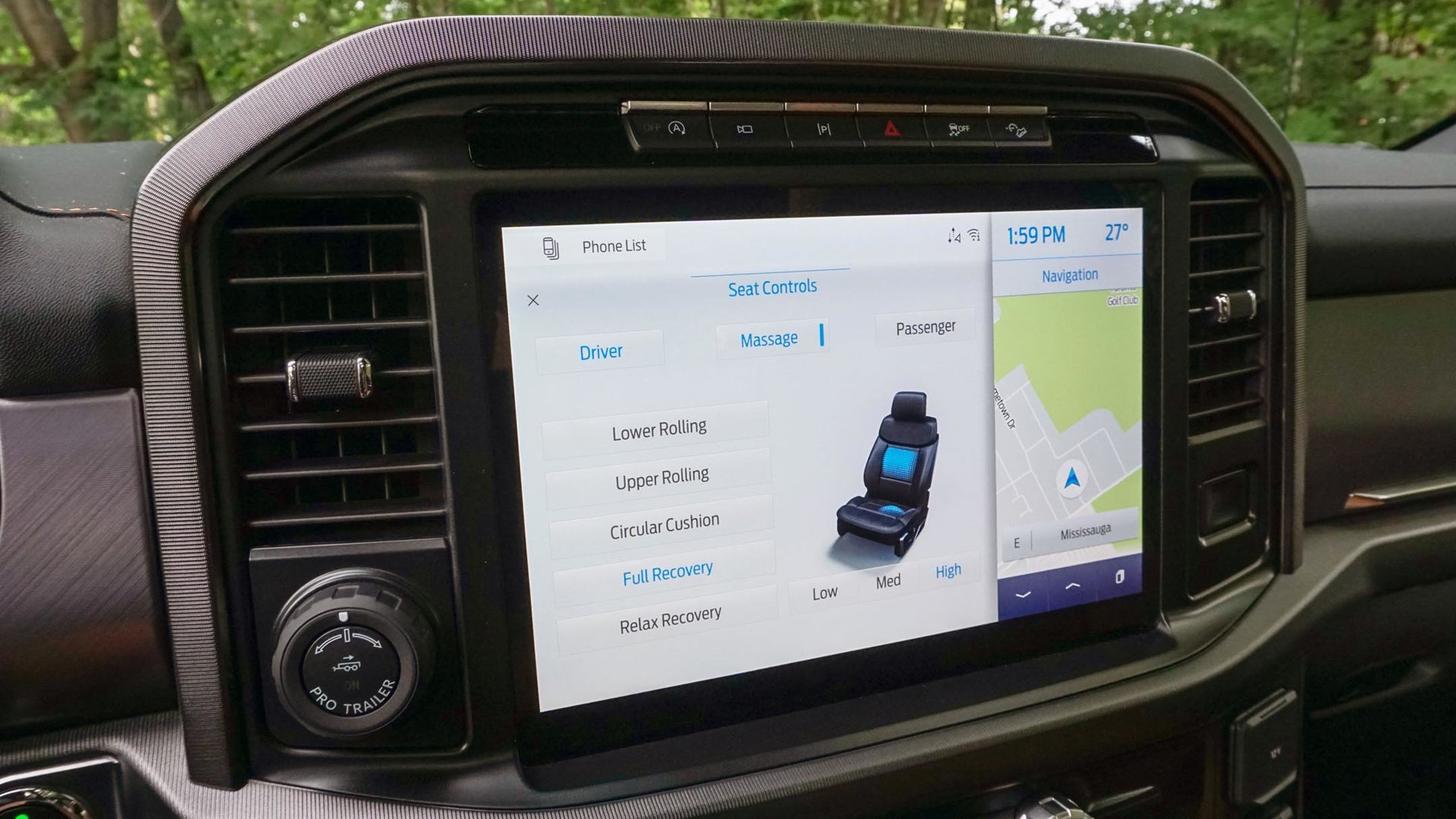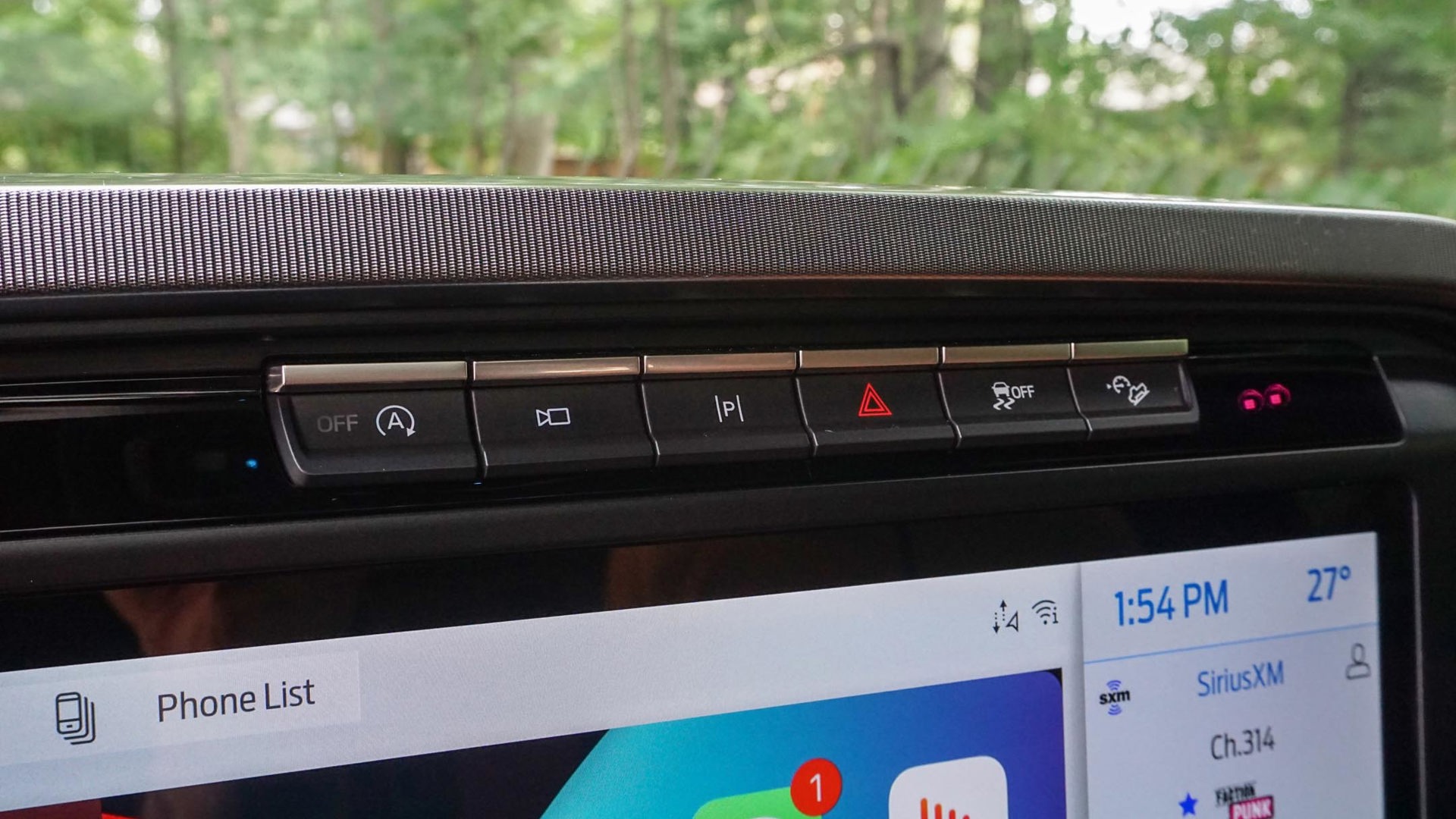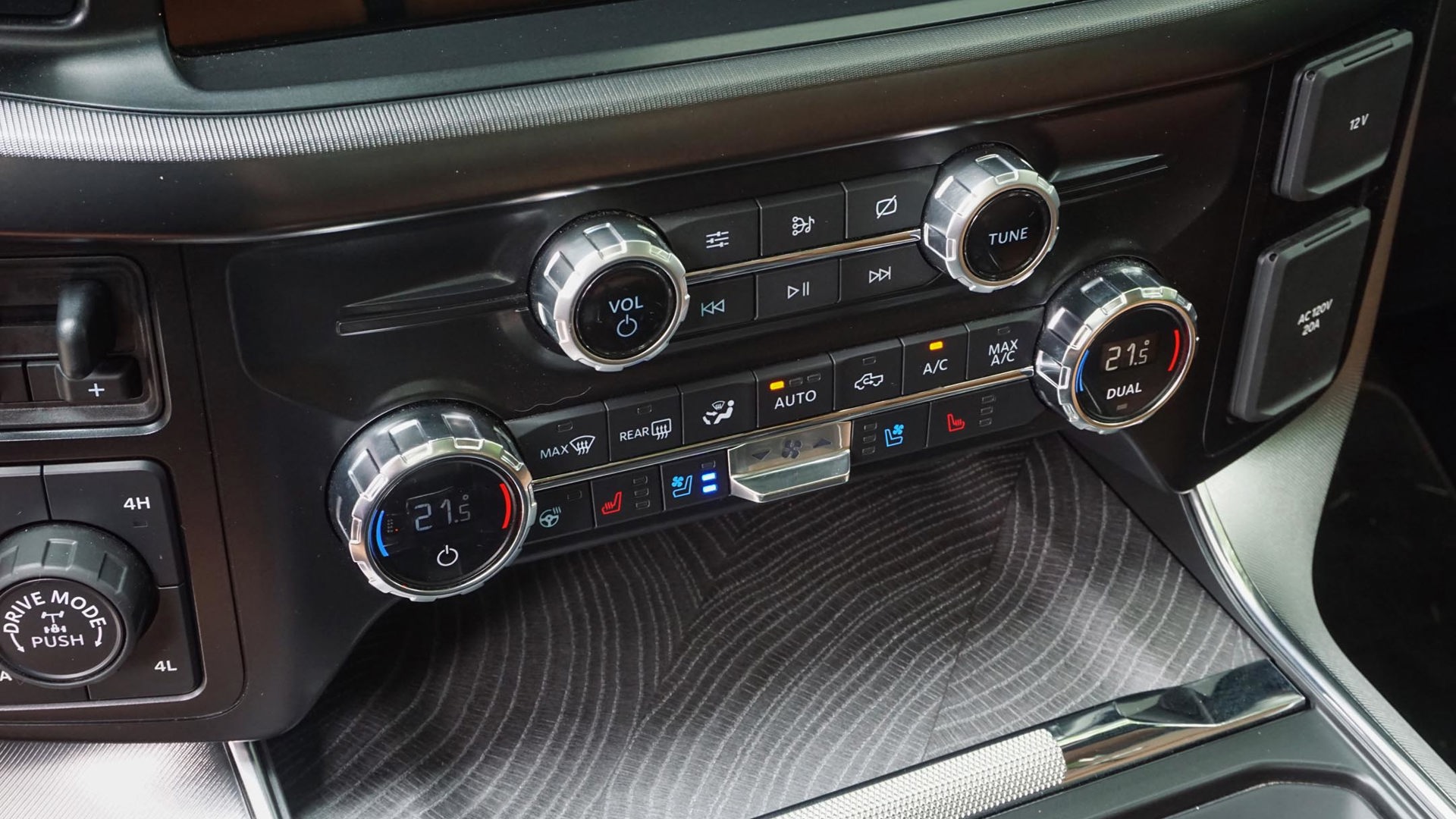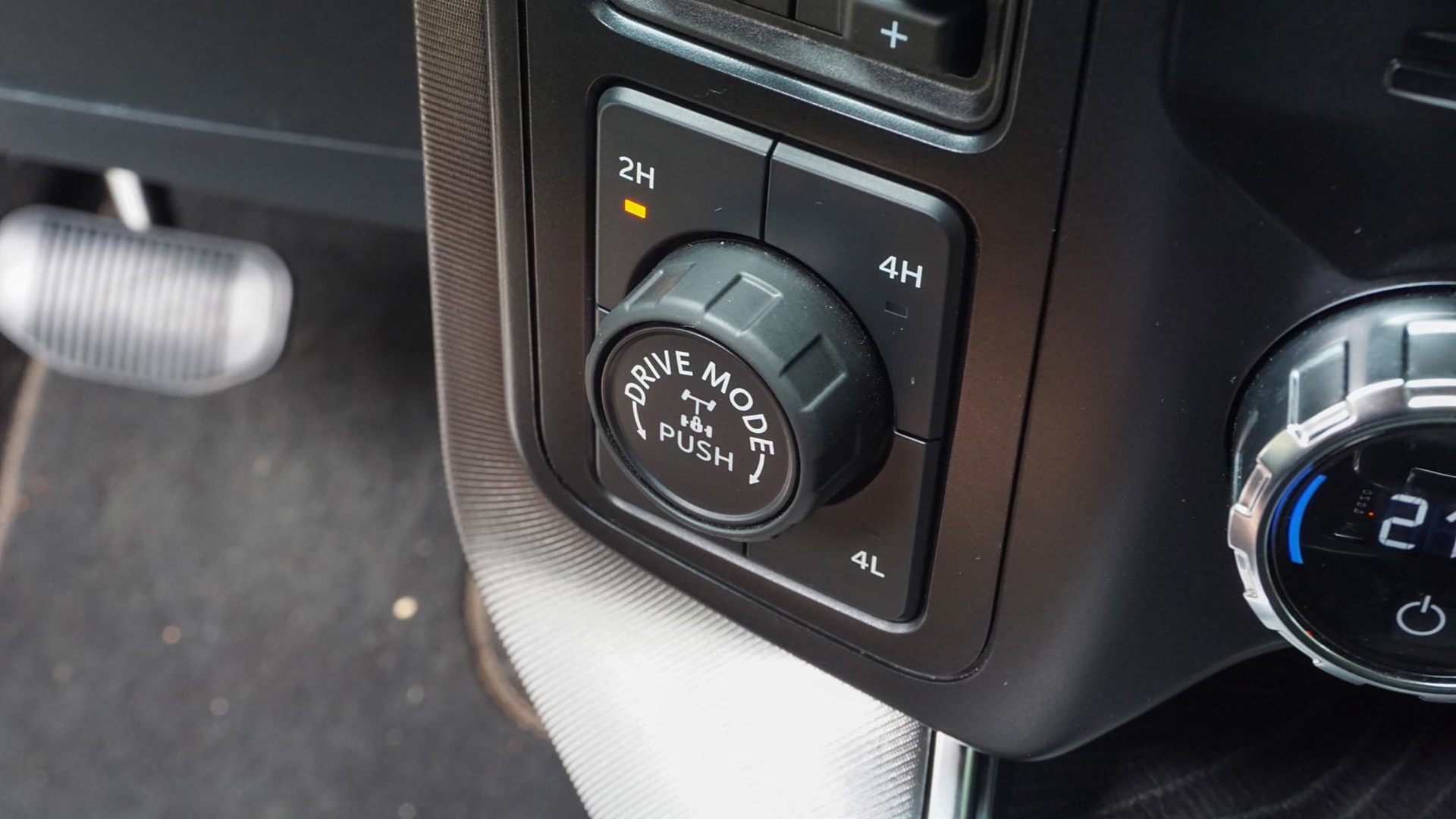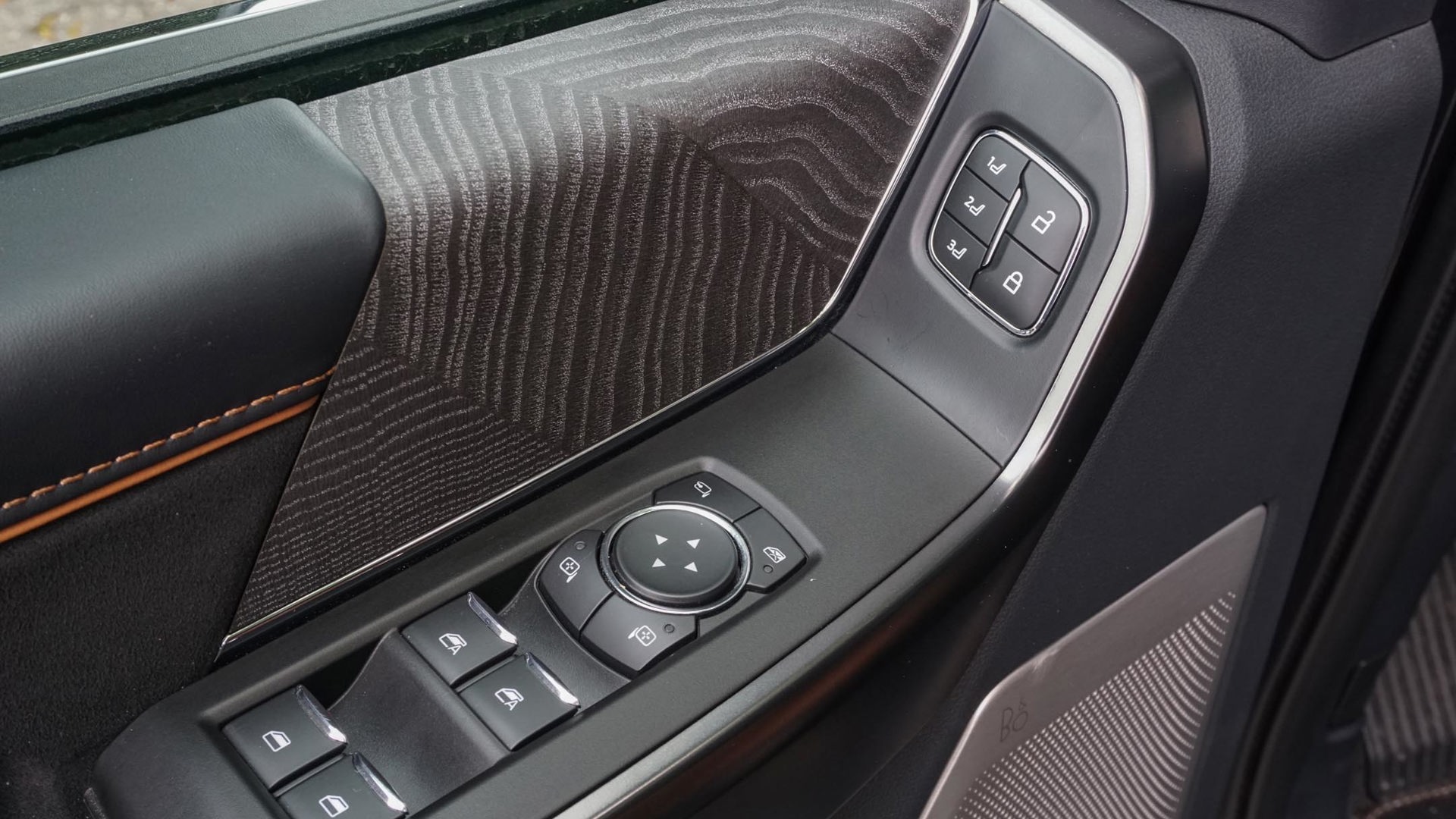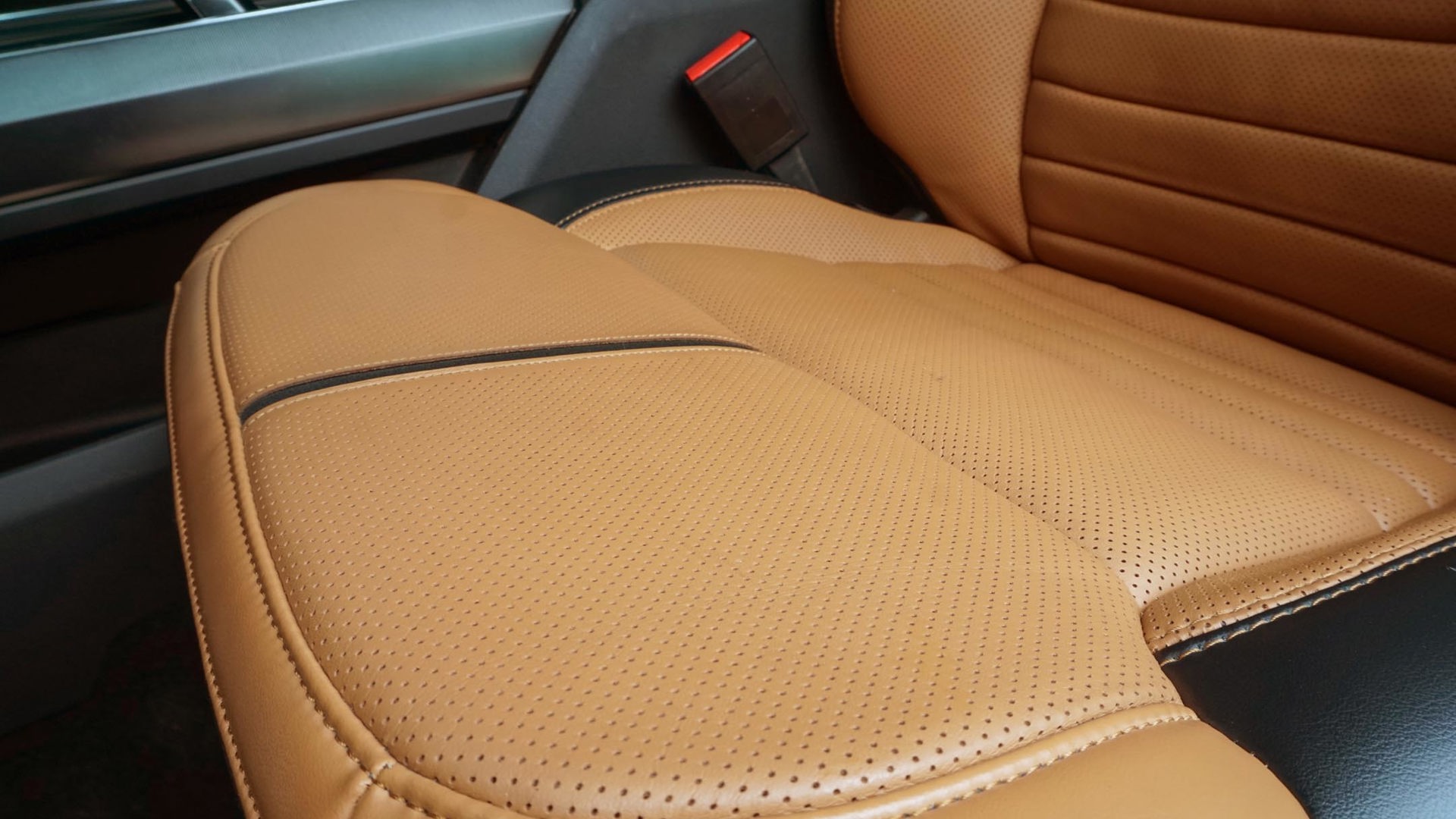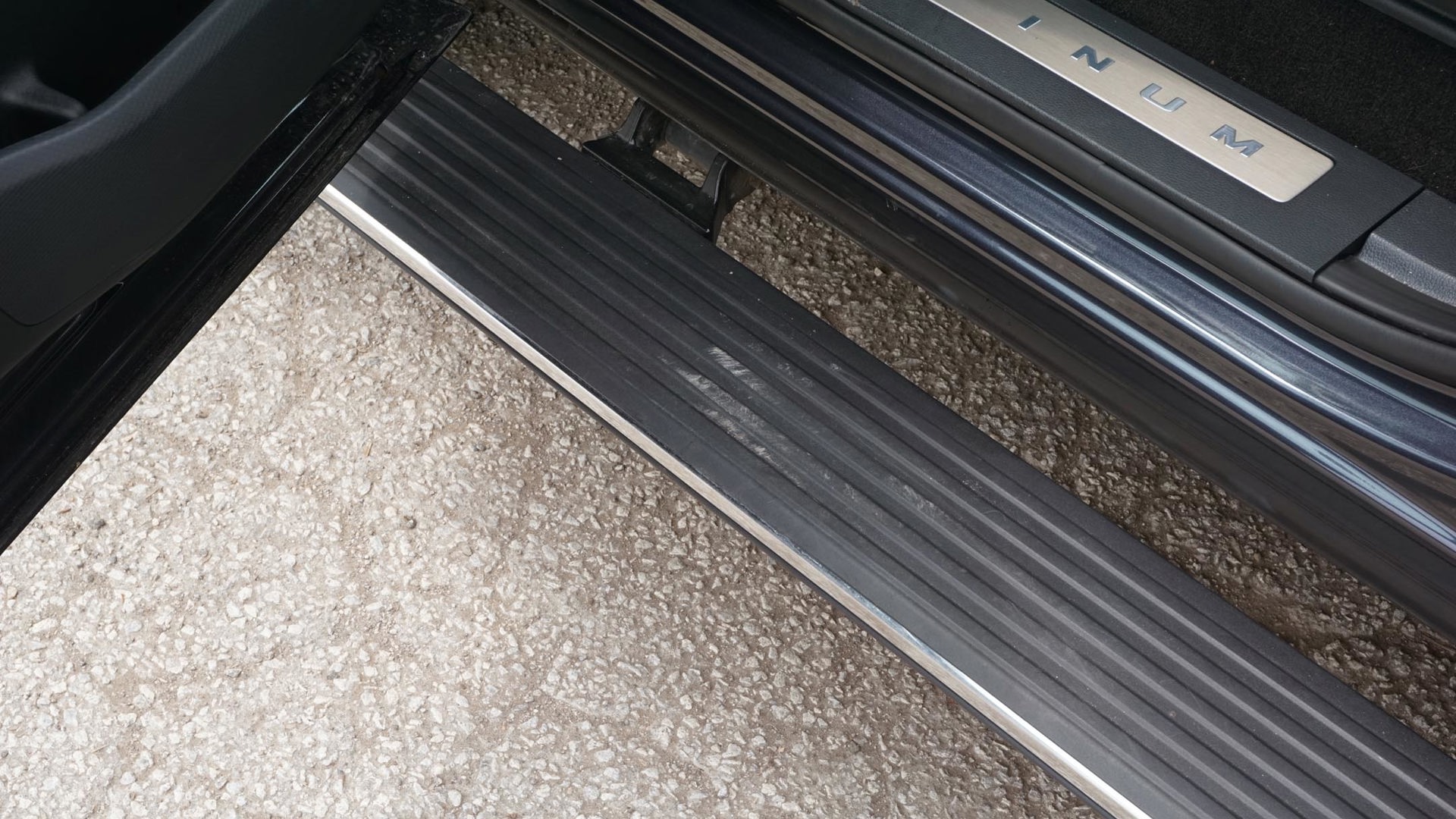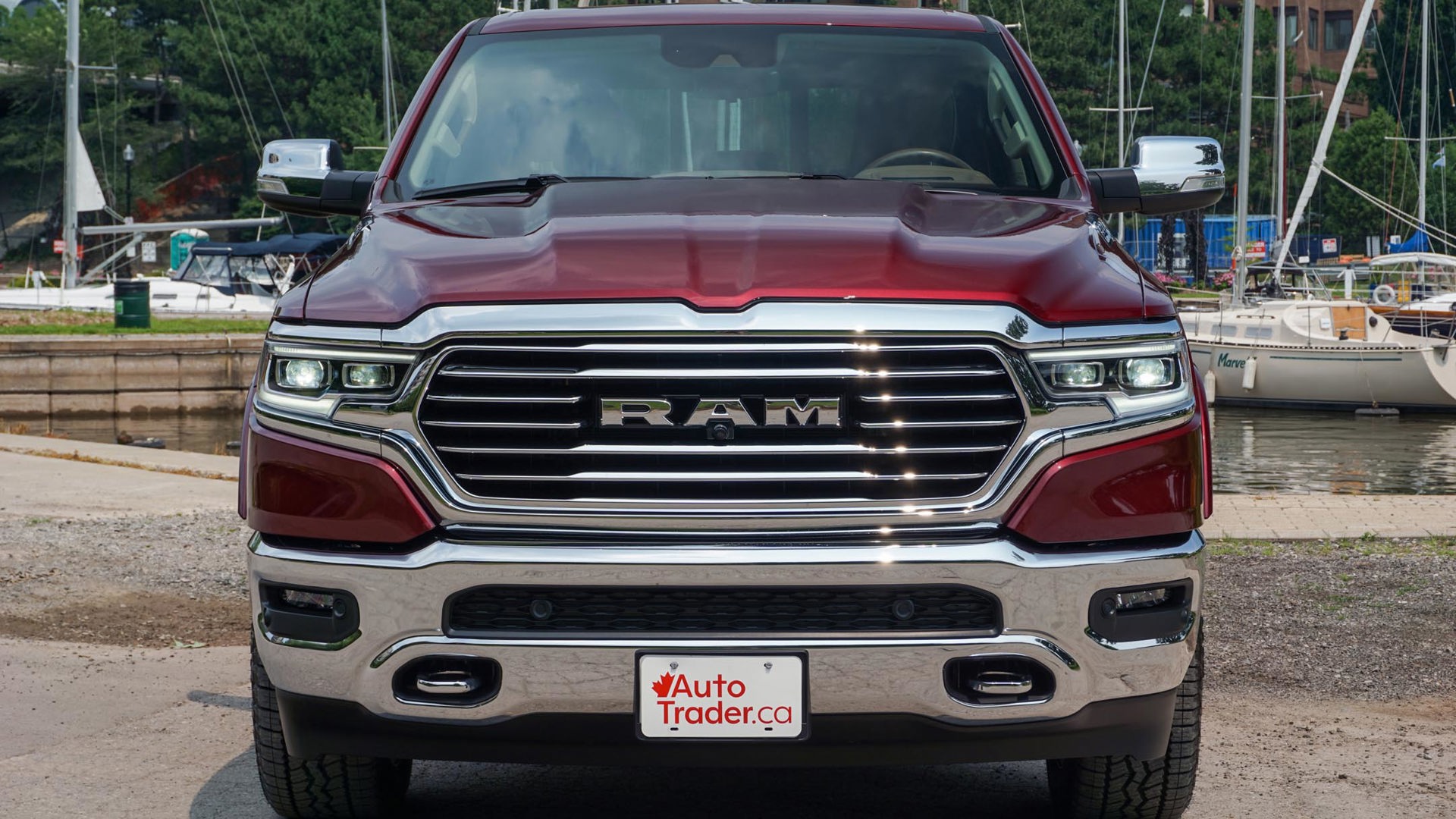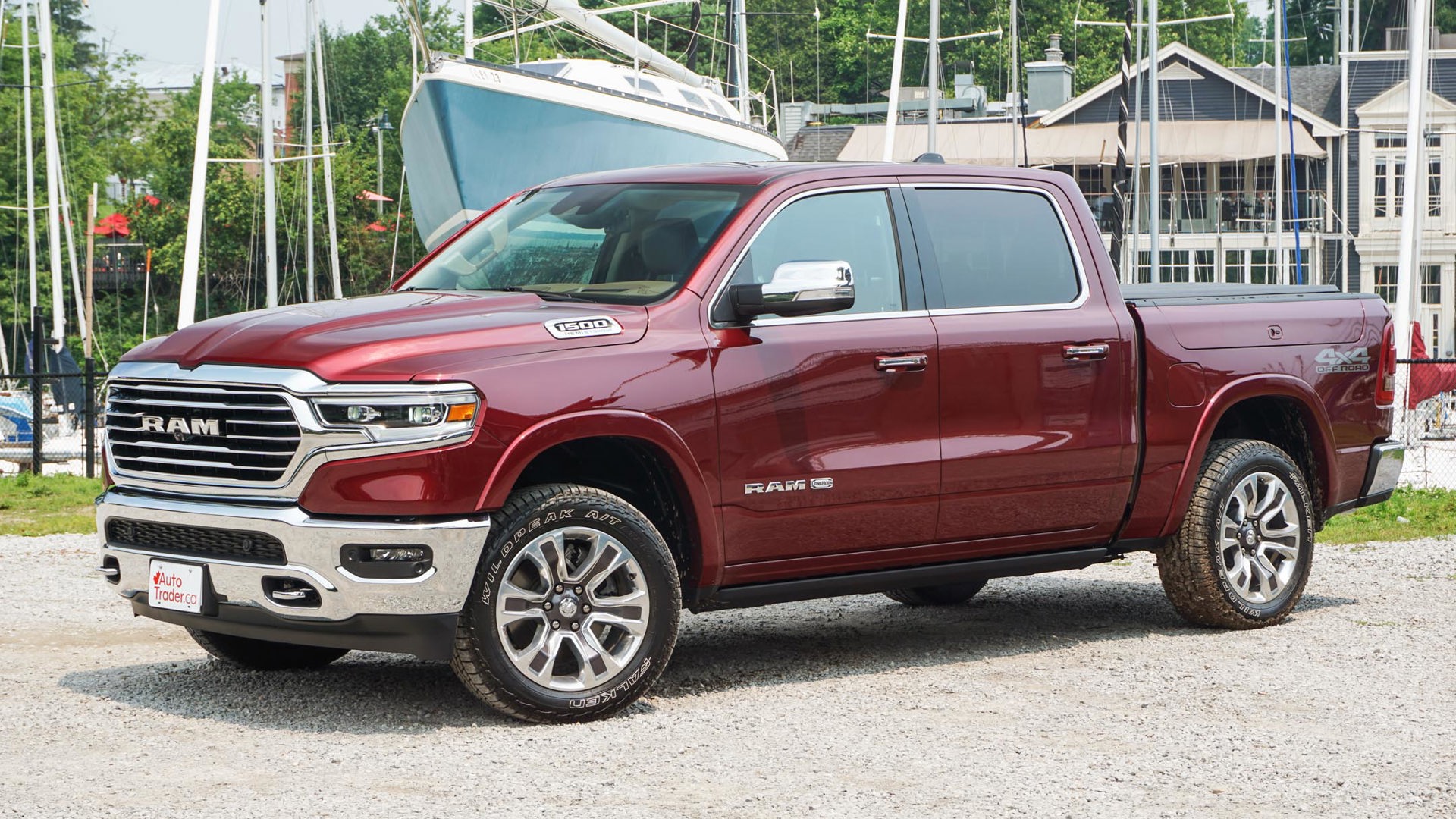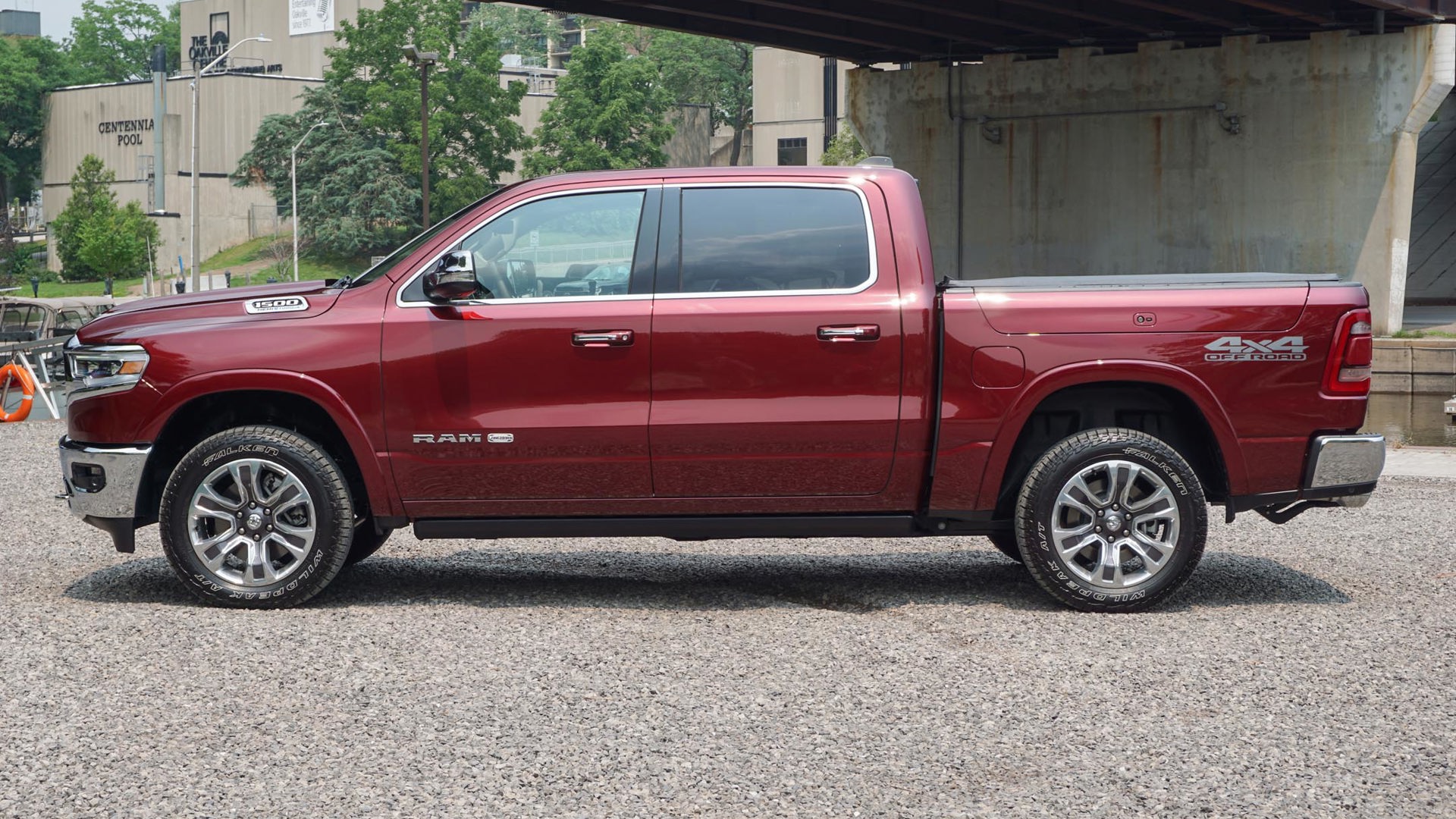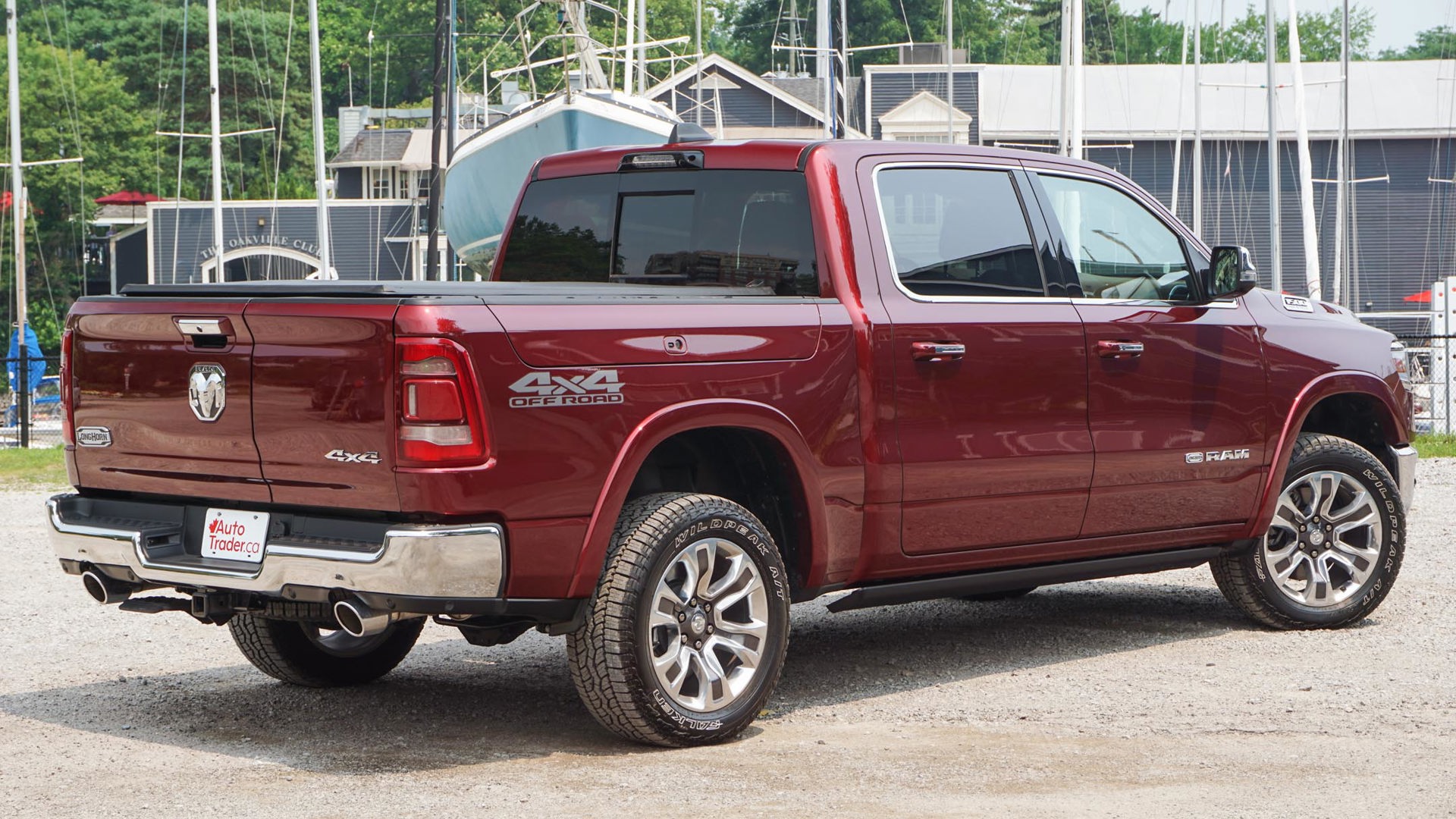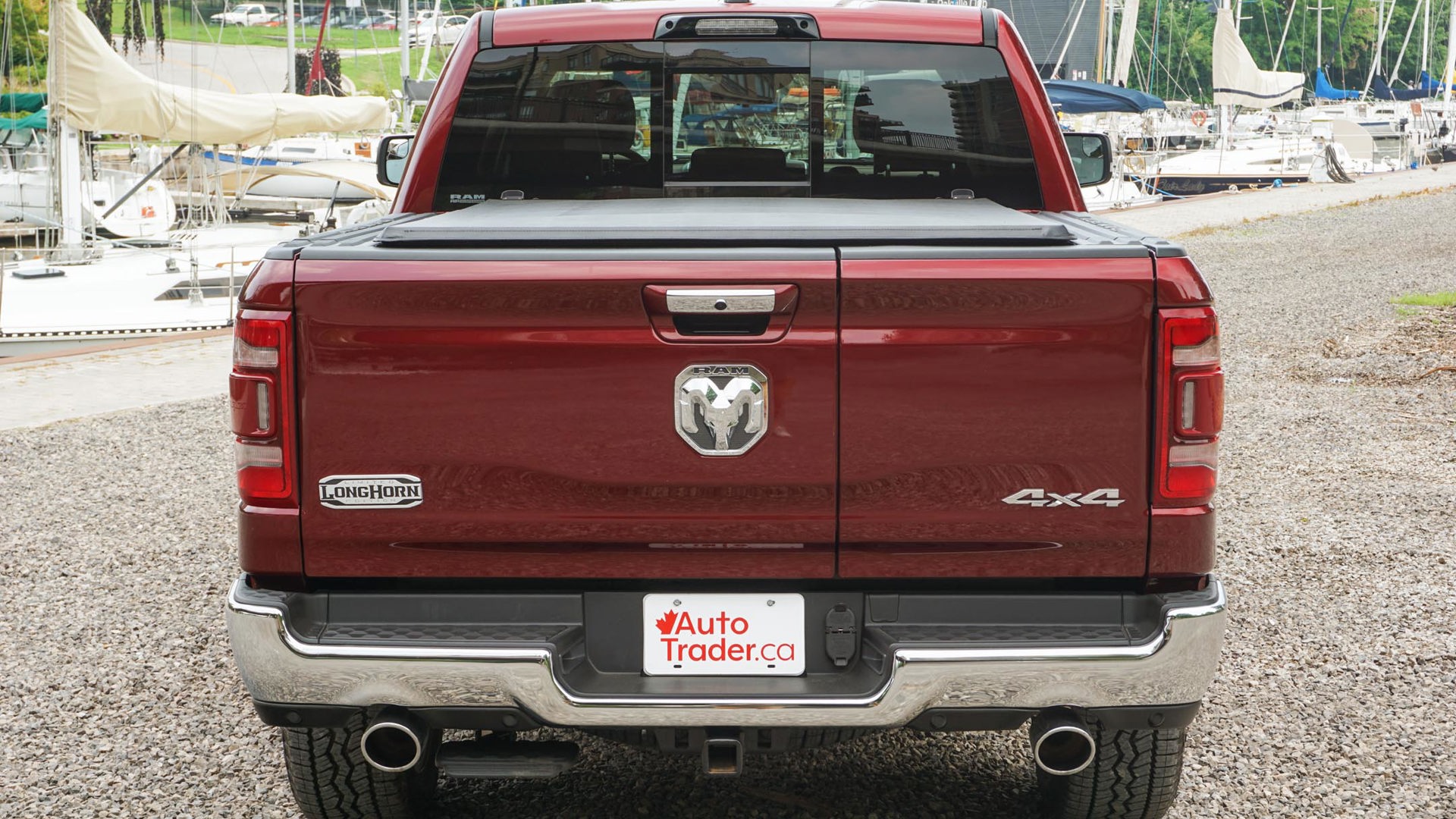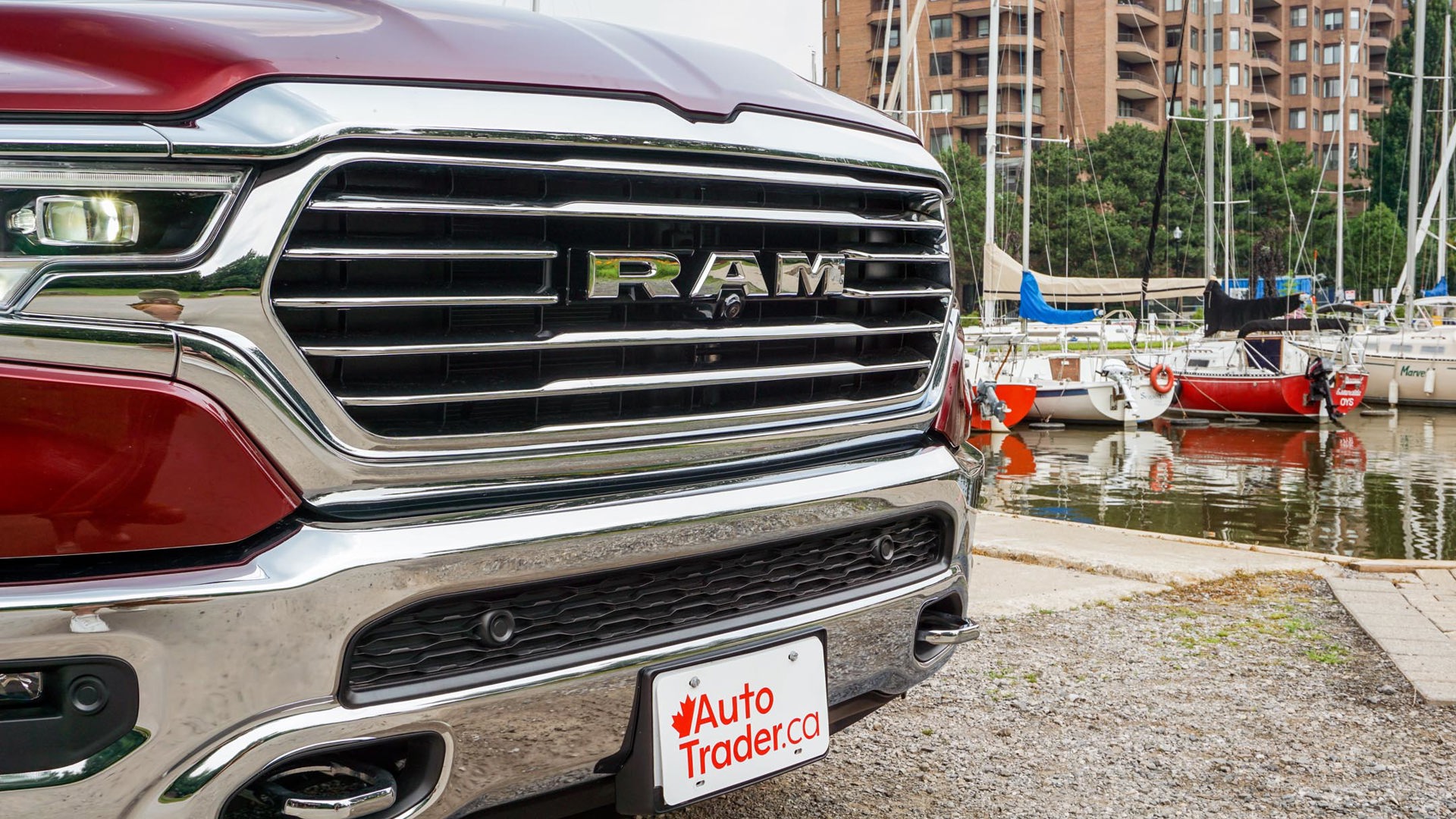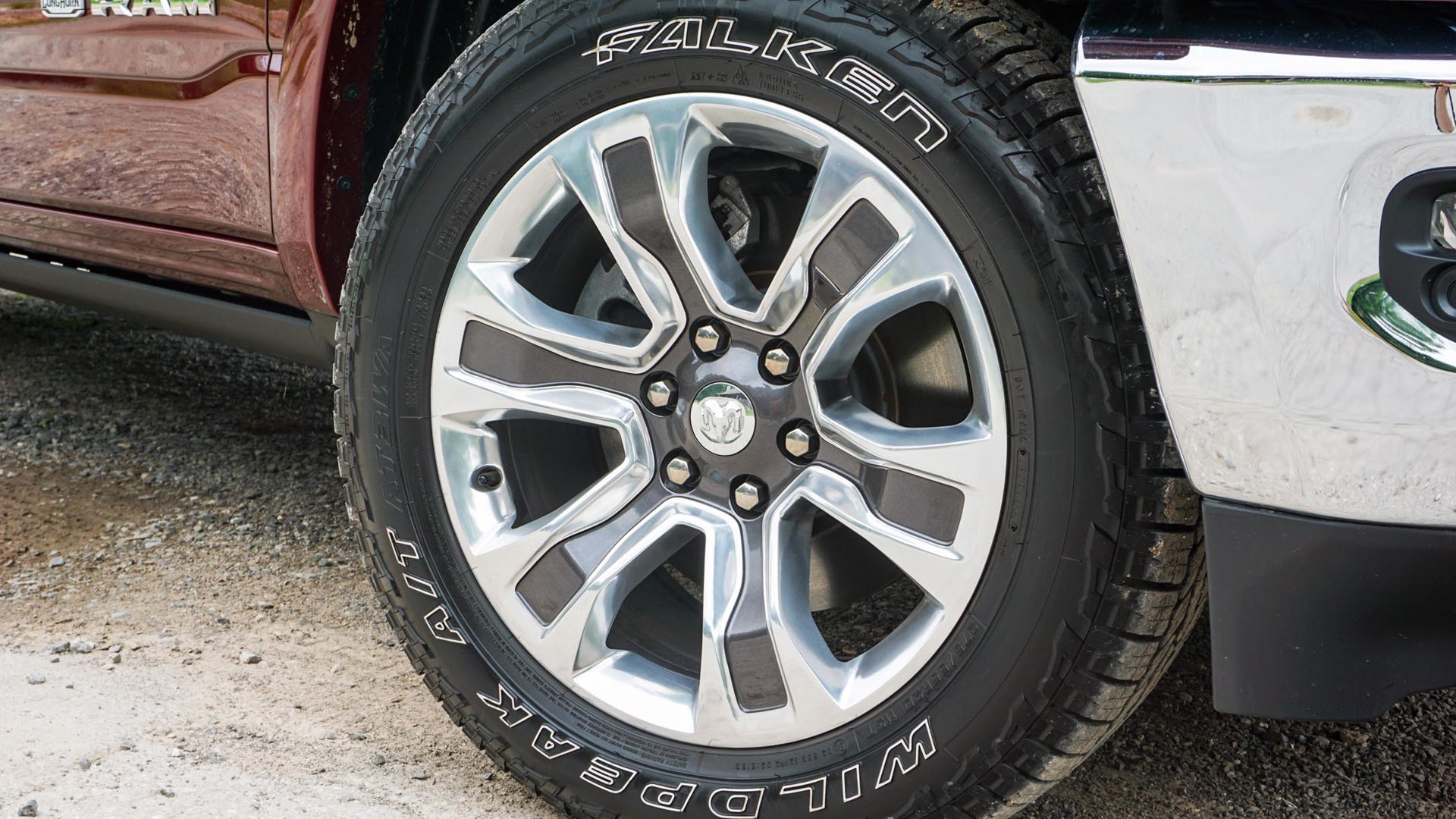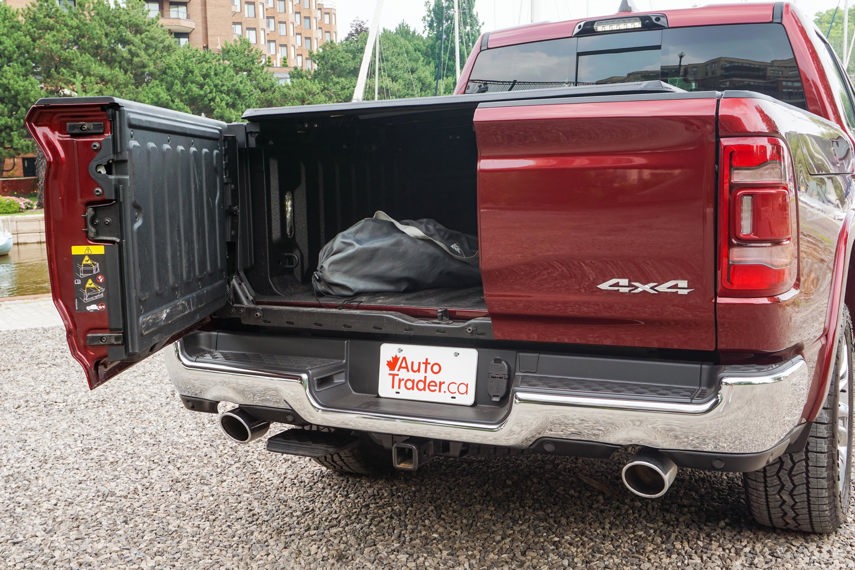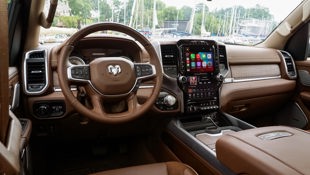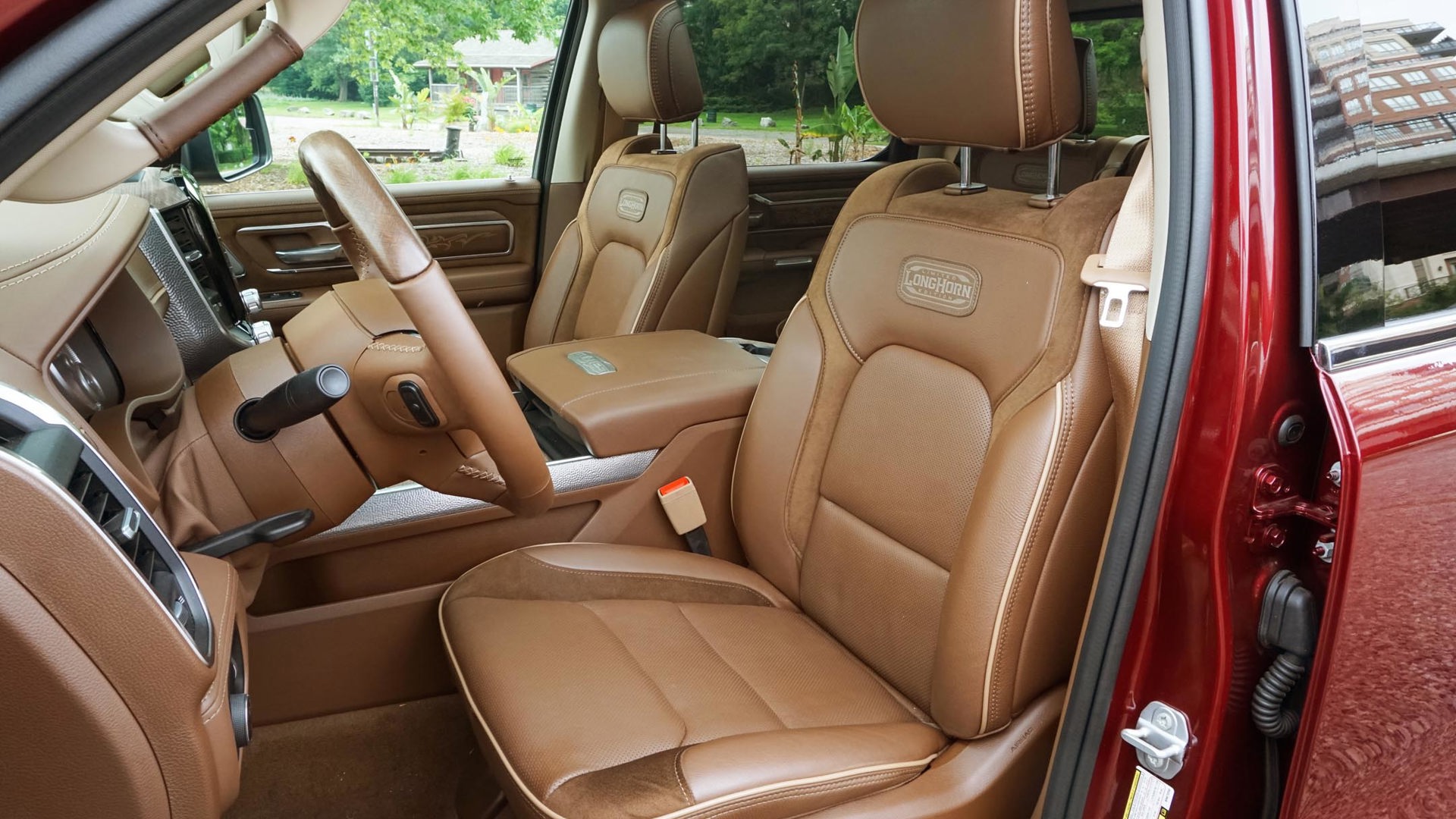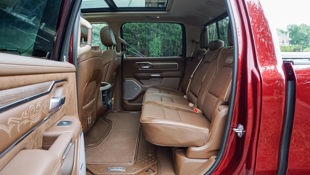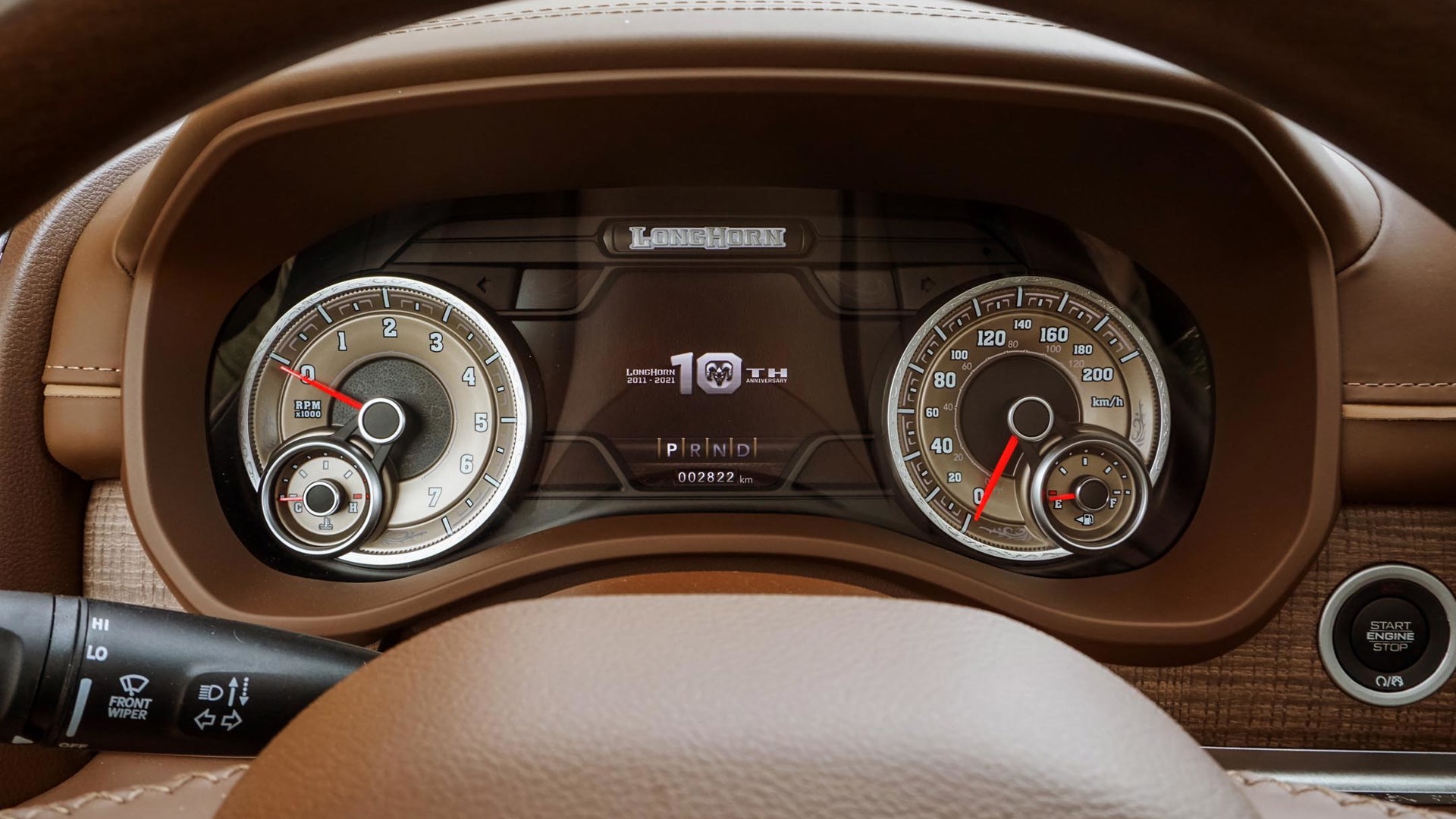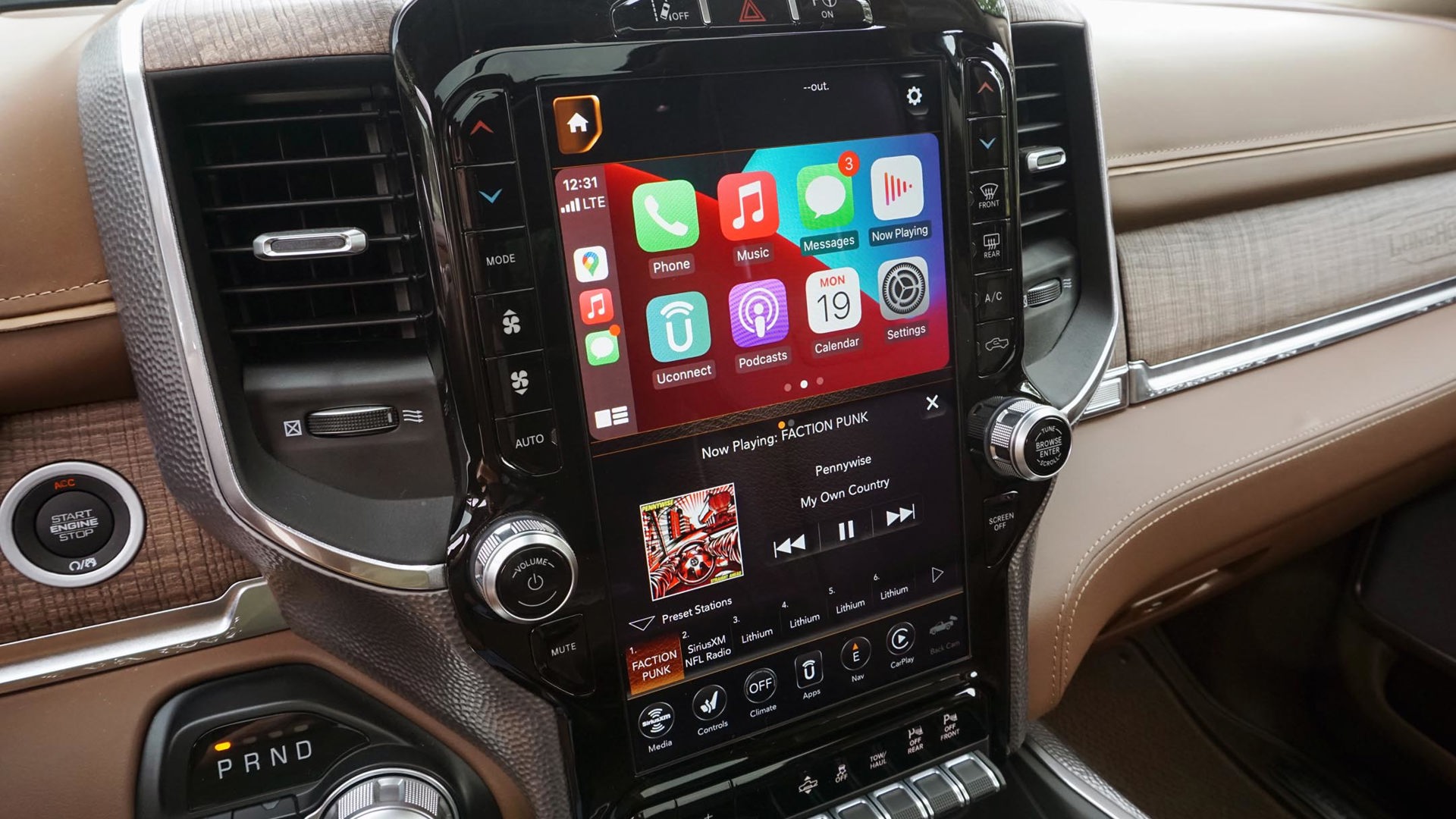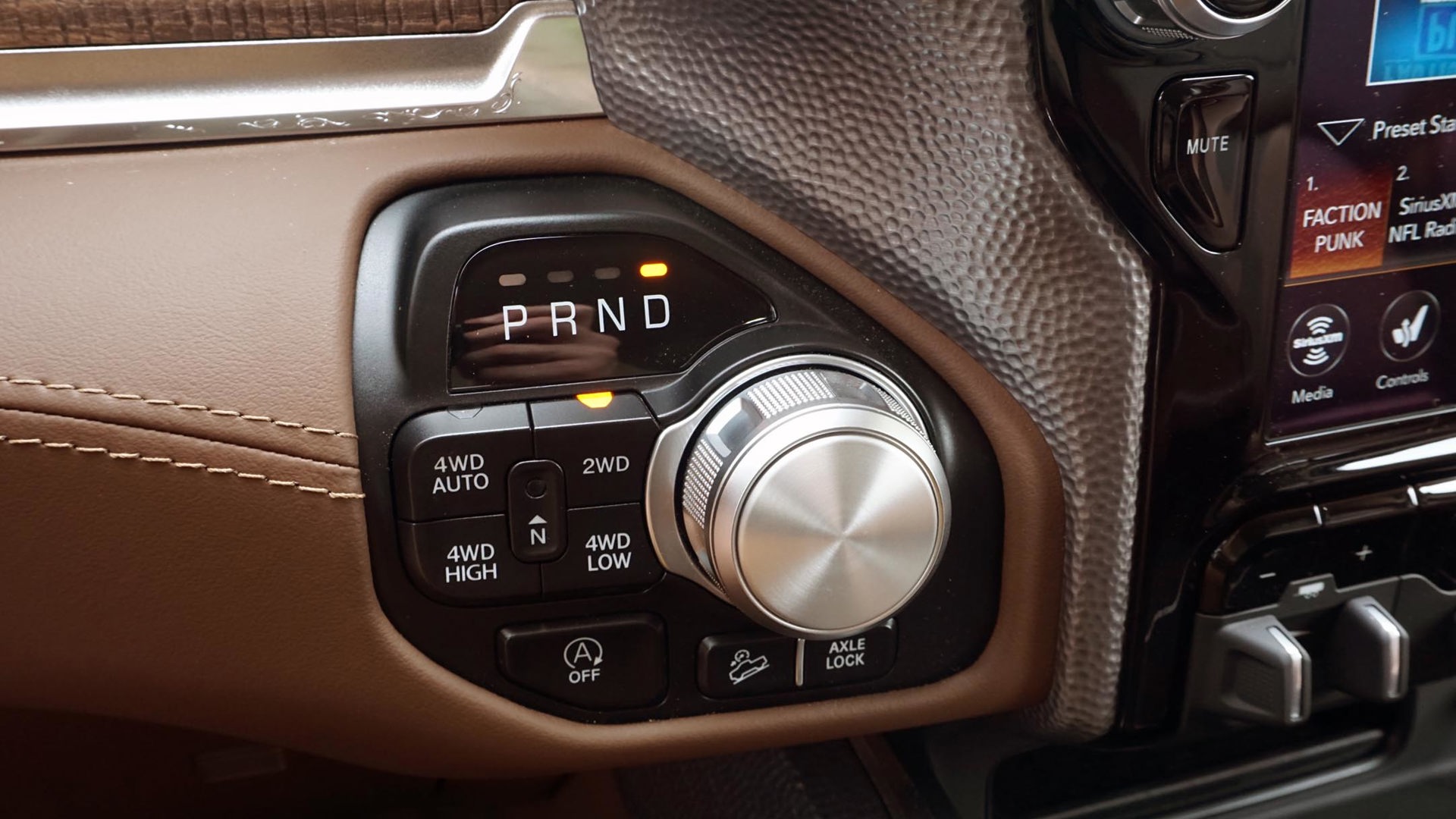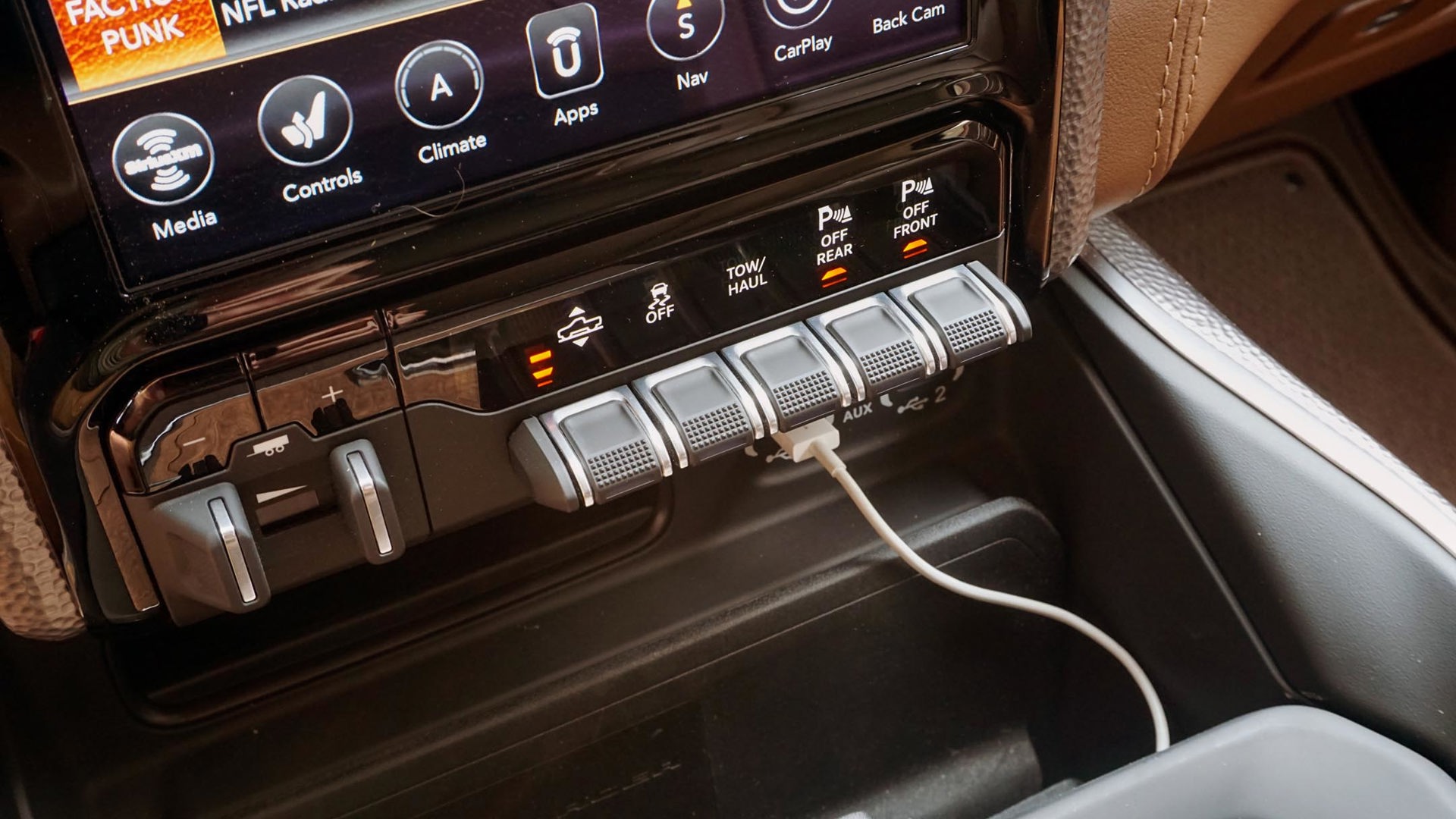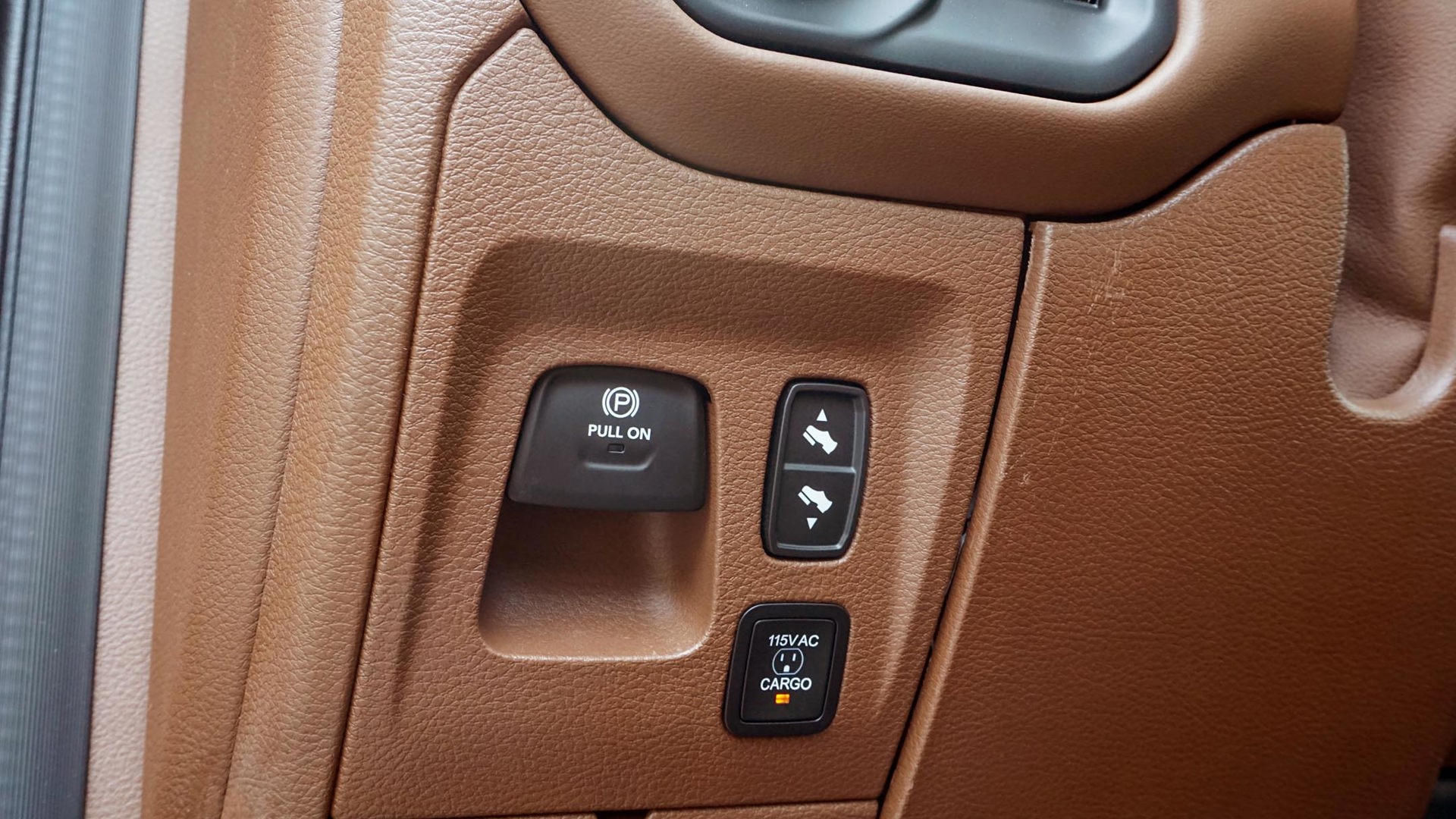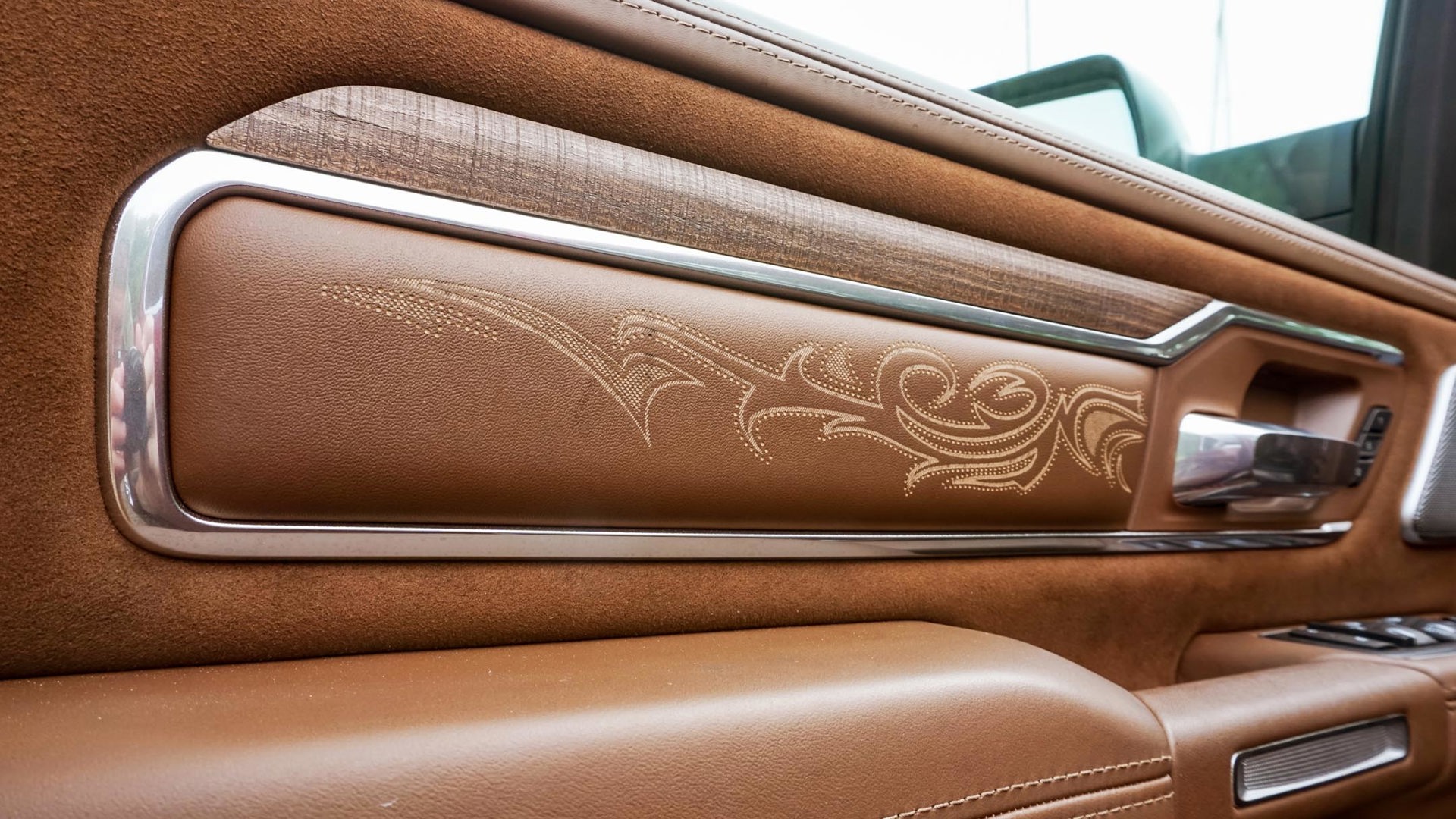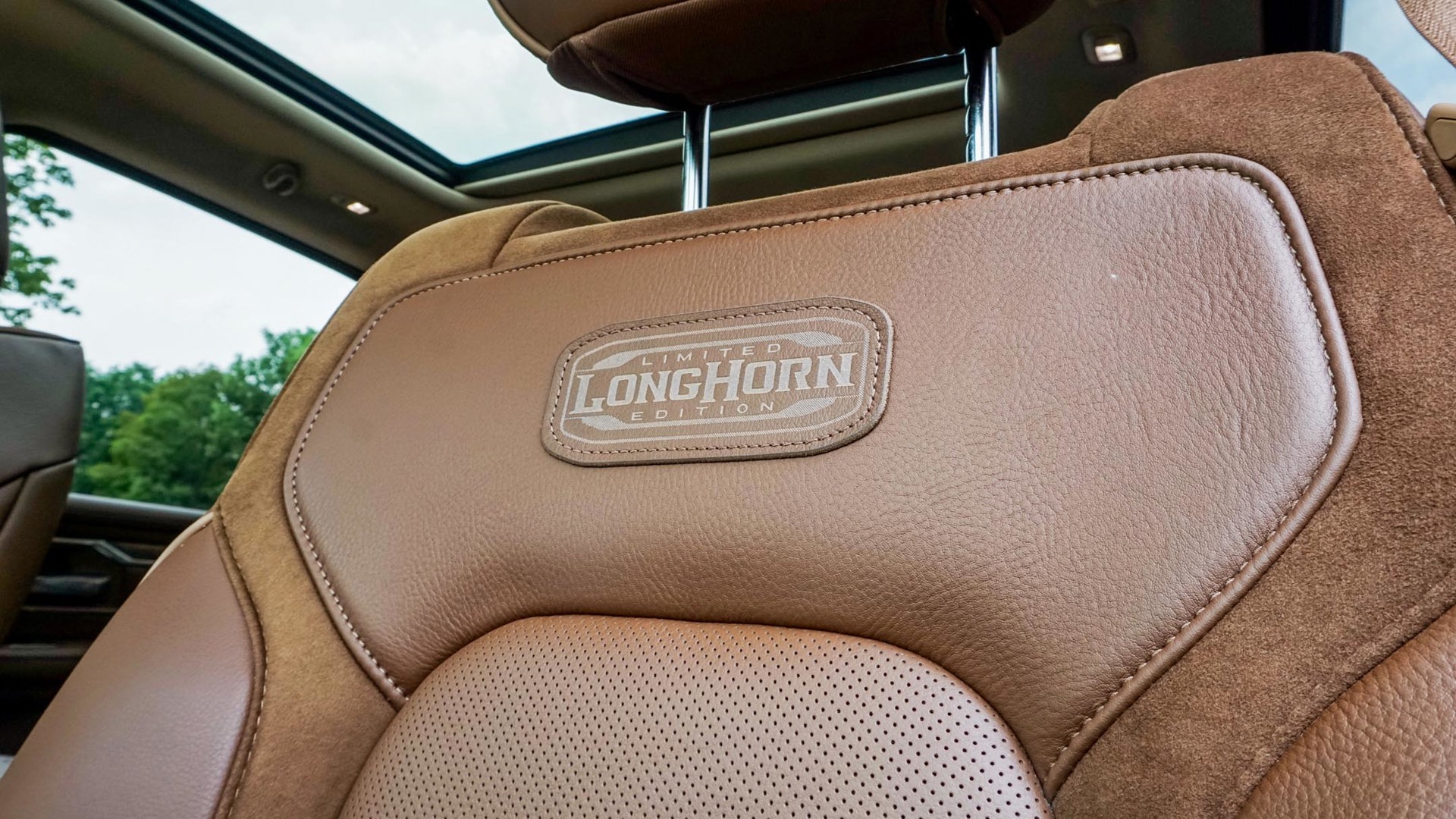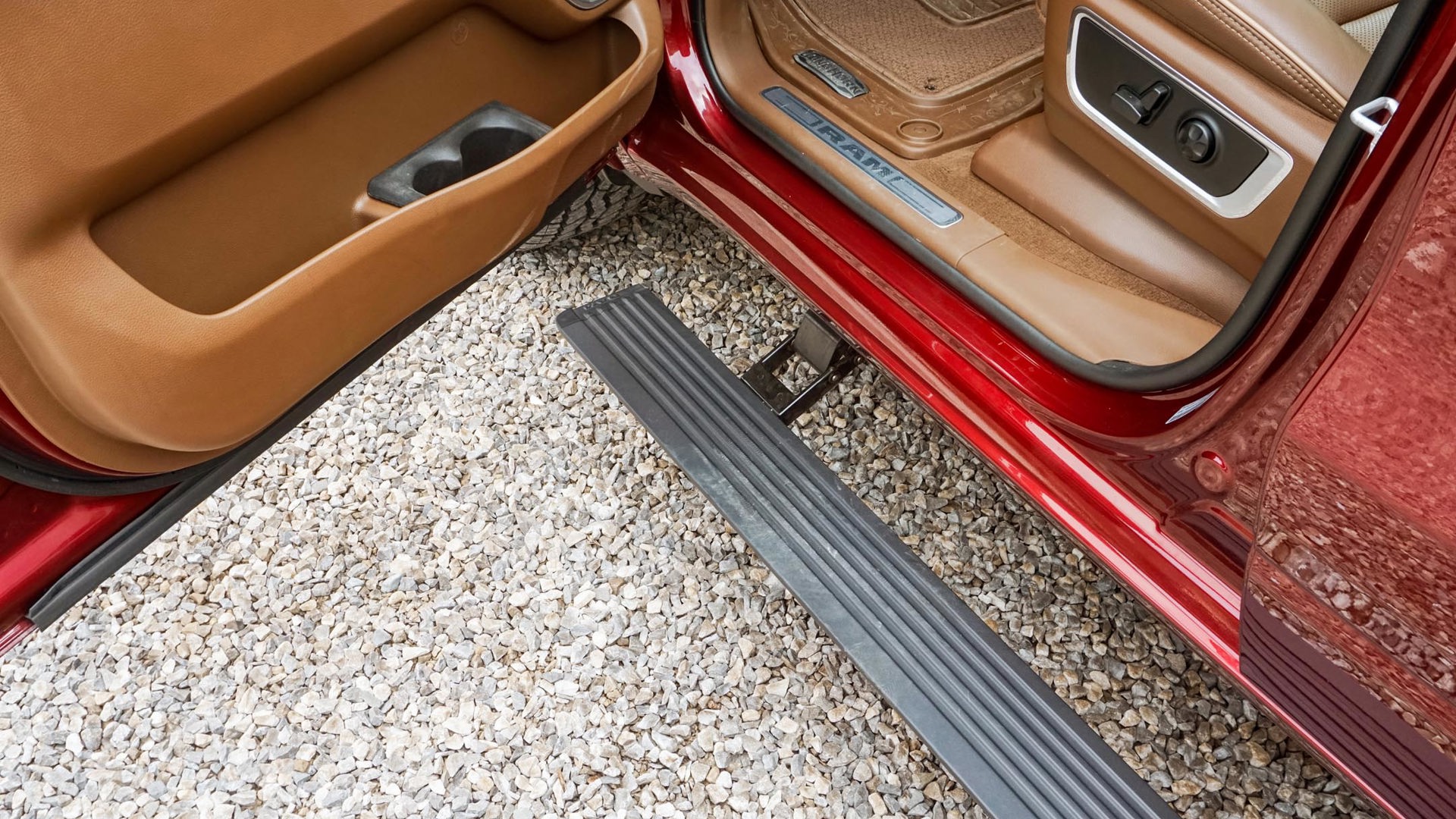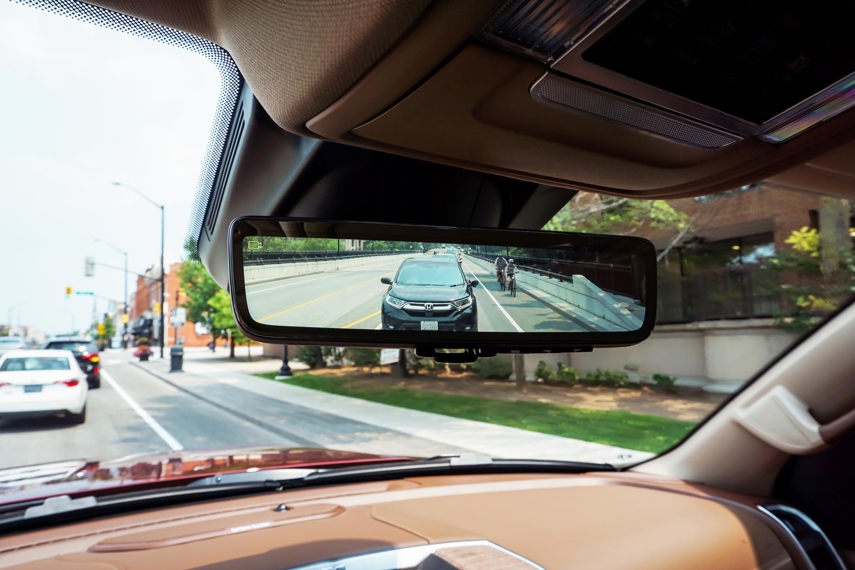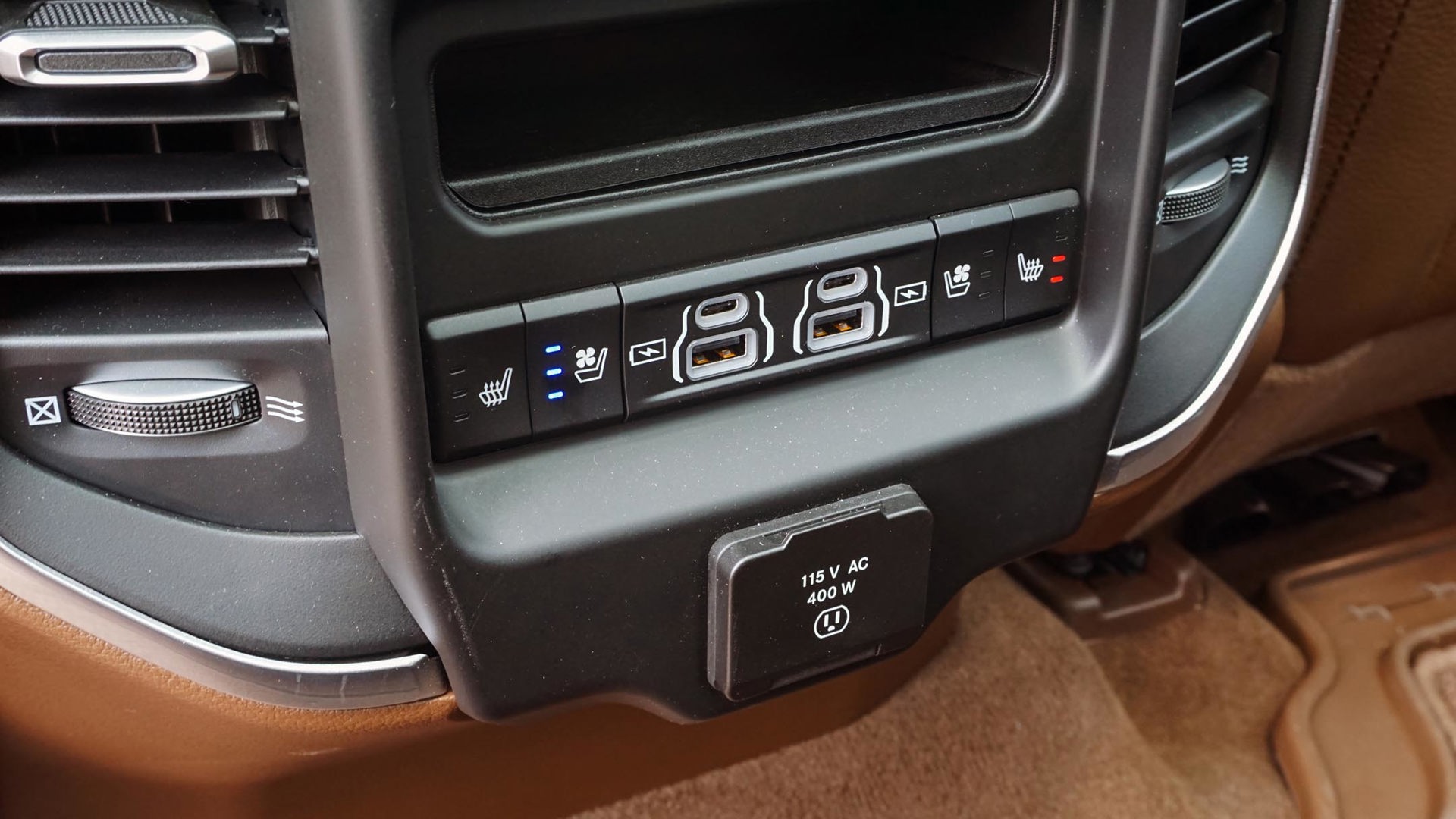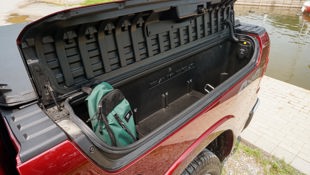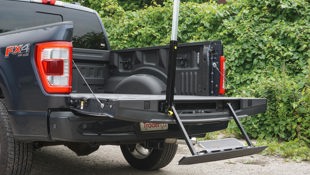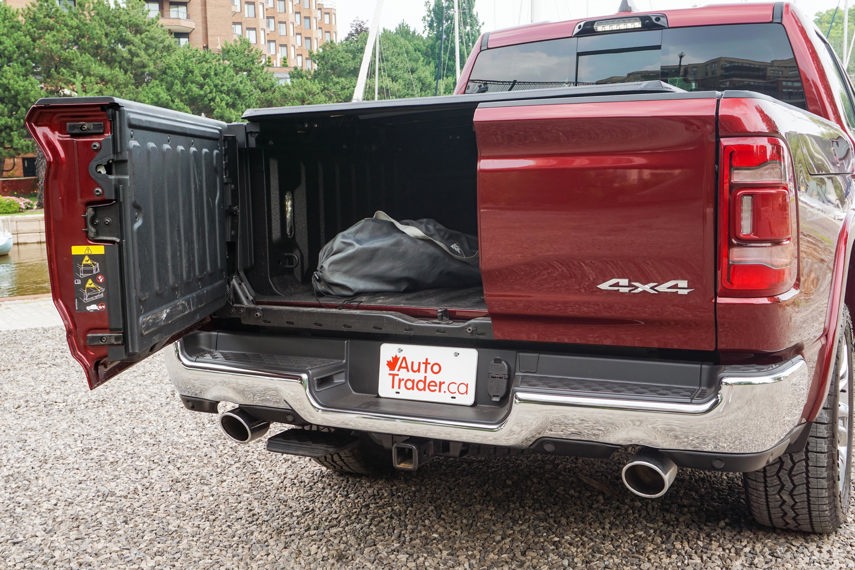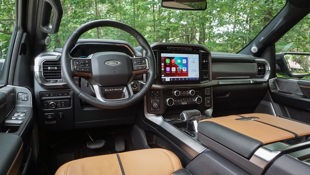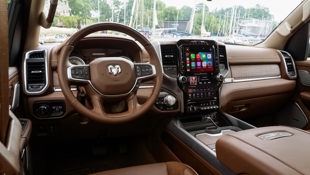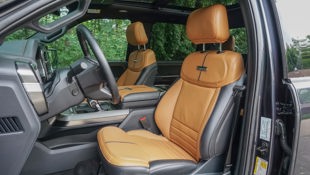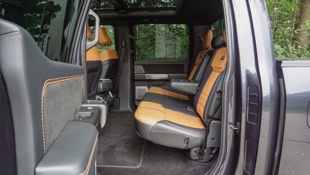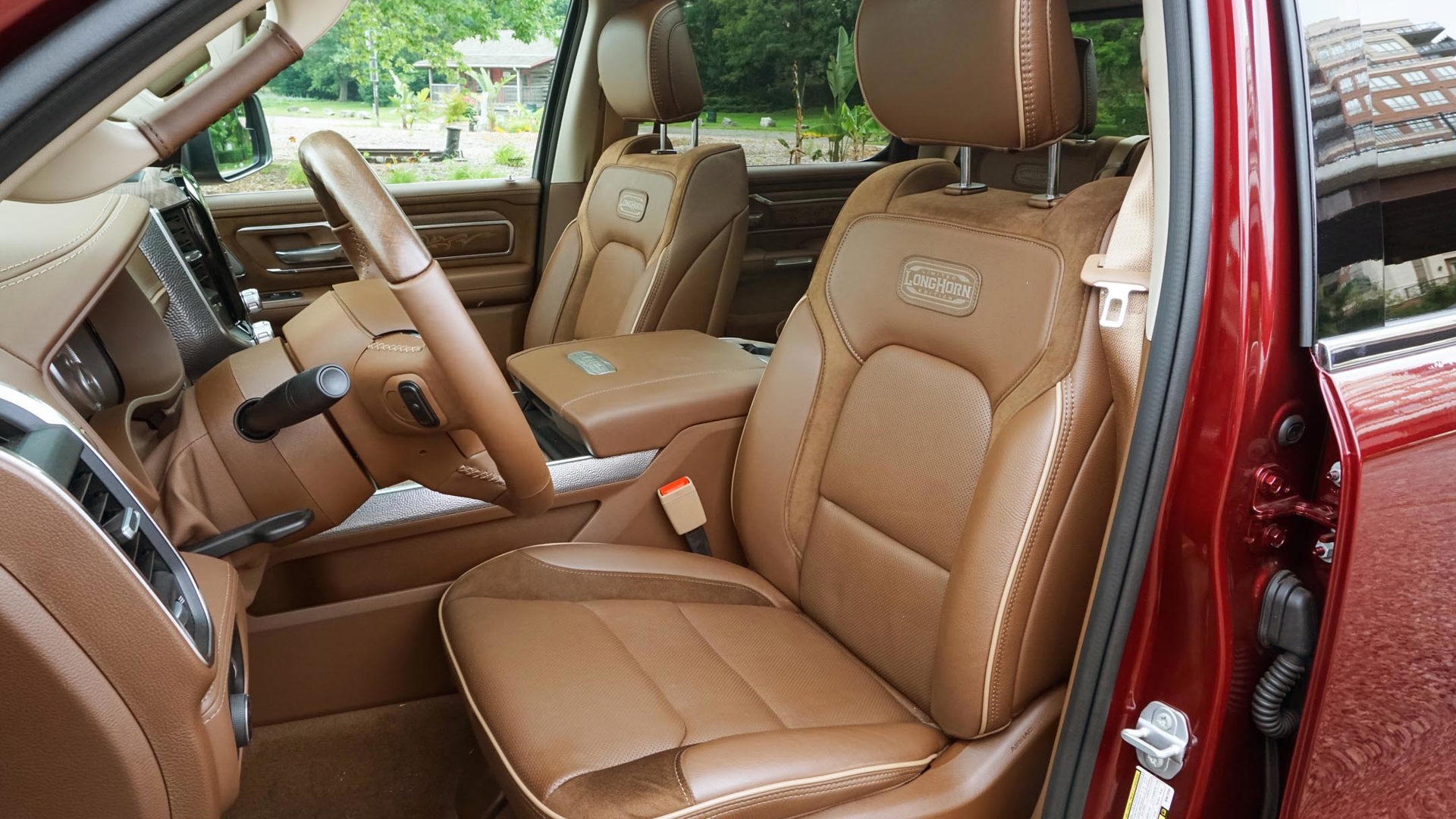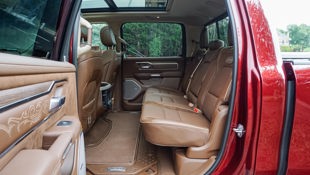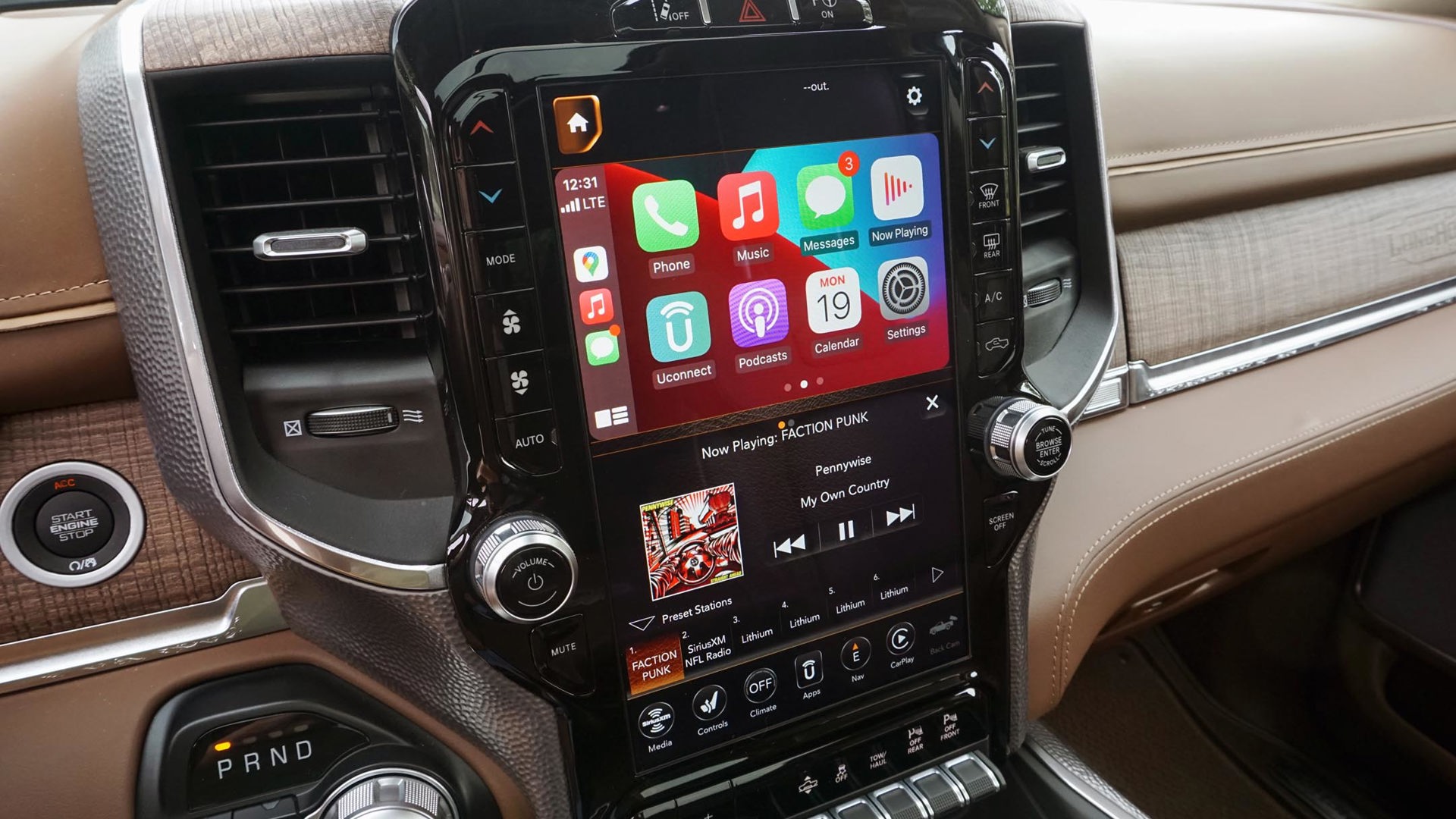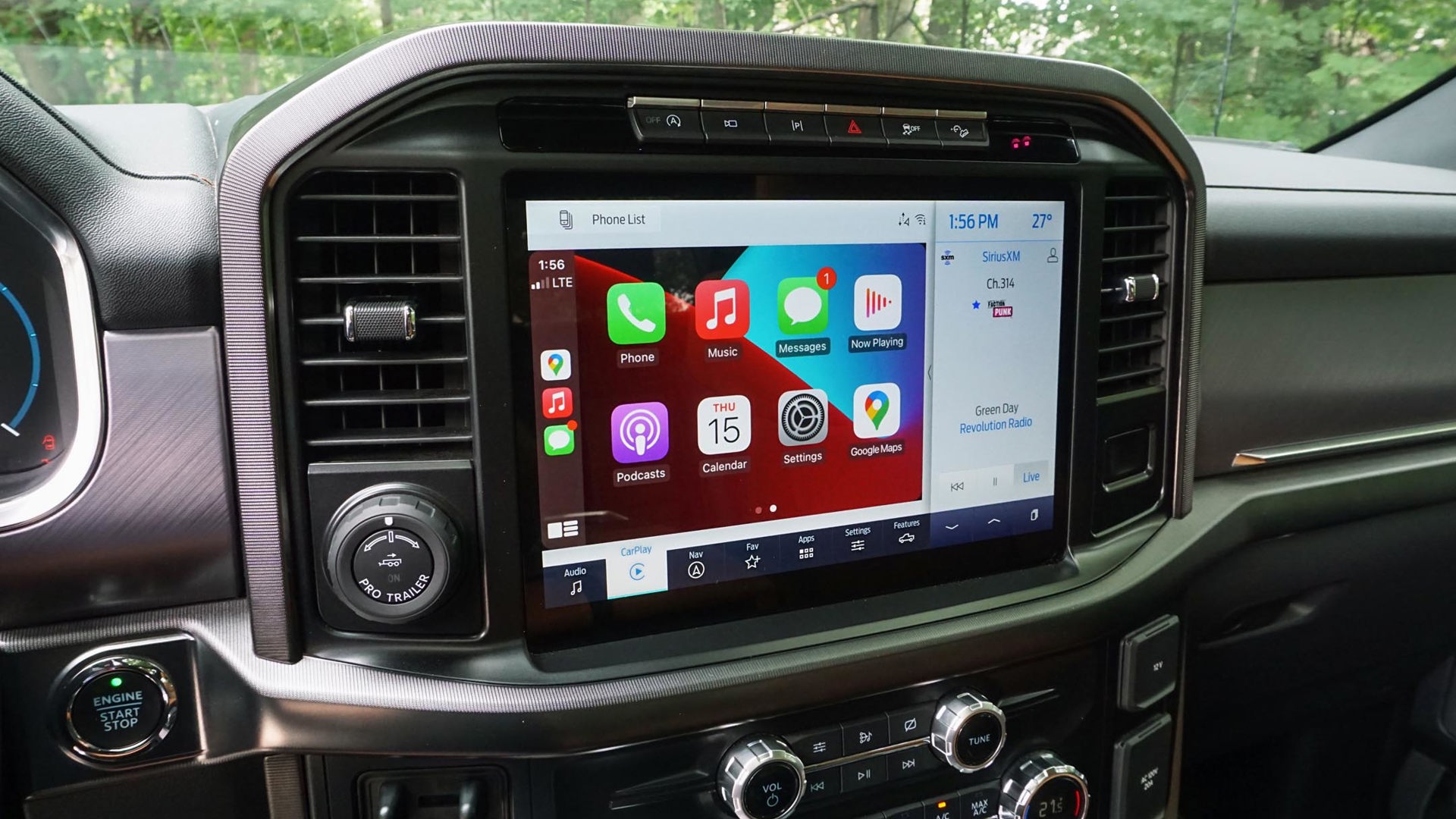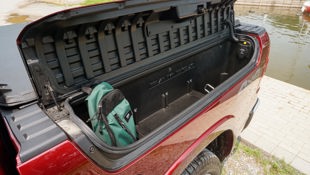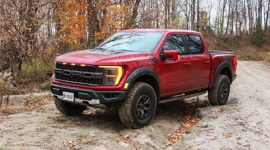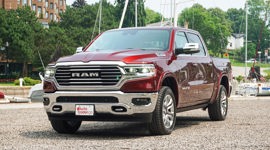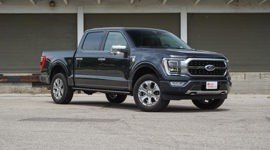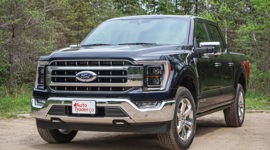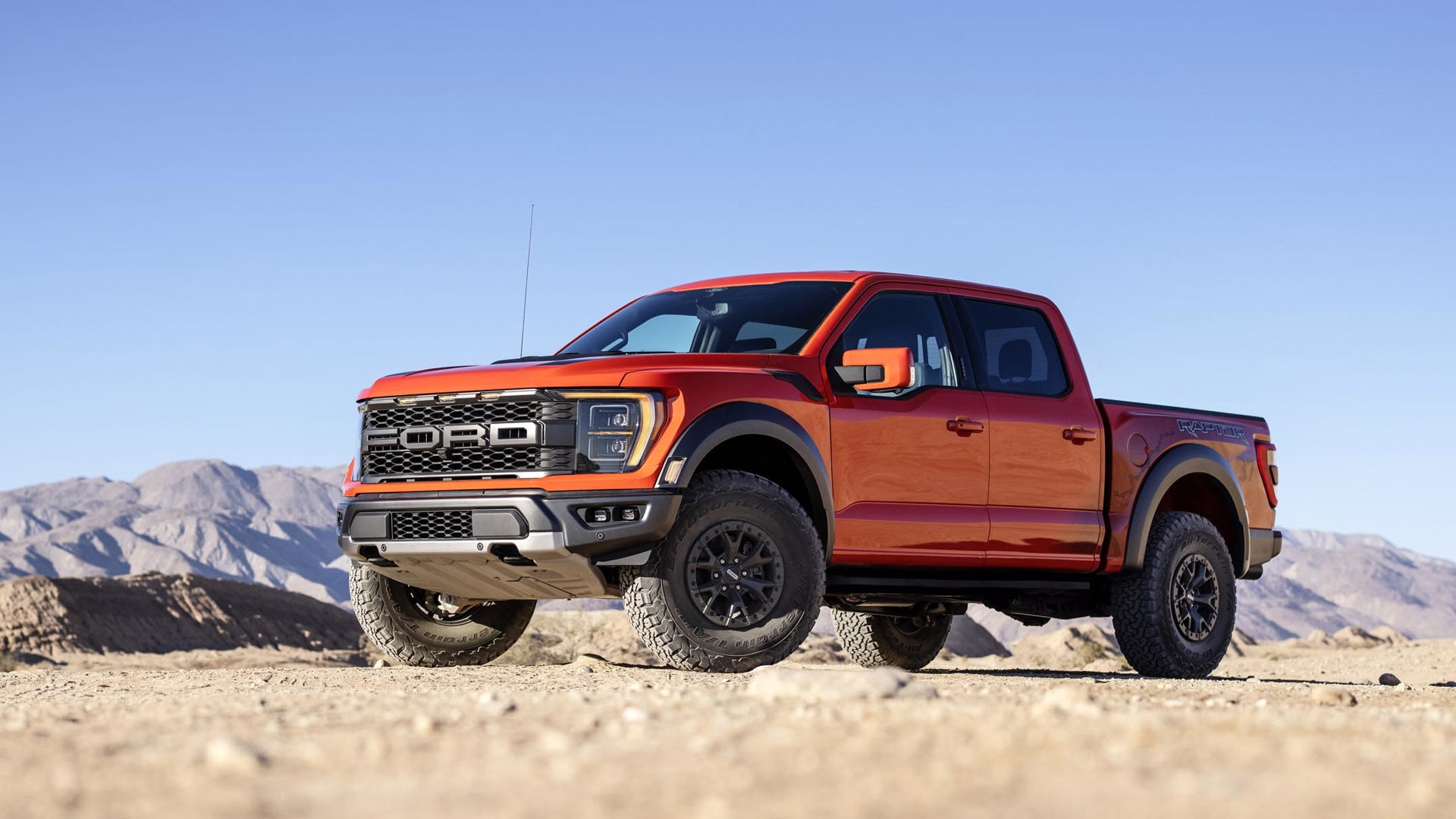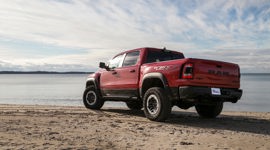Comparison Data
|
2021 Ford F-150 Platinum 4WD
|
2021 Ram 1500 Limited Longhorn 4WD
|
|---|---|
|
Engine Displacement
3.5L
|
5.7L
|
|
Engine Cylinders
Turbo V6
|
V8
|
|
Peak Horsepower
400 hp @ 6,000 rpm
|
395 hp @ 5,600 rpm
|
|
Peak Torque
500 lb-ft @ 3,100 rpm
|
410 lb-ft @ 3,950 rpm
|
|
Fuel Economy
13.5 / 10.2 / 12.0 L/100 km cty/hwy/cmb
|
14.0 / 10.7 / 12.5 L/100 km cty/hwy/cmb
|
|
Cargo Space
1,765 L
|
1,526 L
|
|
Base Price
$81,305
|
$73,915
|
|
A/C Tax
$100
|
$100
|
|
Destination Fee
$1,995
|
$1,995
|
|
Price as Tested
$88,350
|
$94,600
|
|
Optional Equipment
$4,950 – Panoramic Sunroof, $1,750; 2.0-kW ProPower Onboard Inverter, $1,300; FX4 Off-Road Package, $950; Spray-in Bedliner, $600; Smoked Quartz Paint, $450; Interior Work Surface, $200; Delete 3.5L EcoBoost Engine, -$300
|
$18,590 – Longhorn Level 1 Equipment Group, $3,595; Advanced Safety Group, $2,300; Air Suspension, $1,895; Panoramic Sunroof, $1,695; Technology Group, $1,595; 10th Anniversary Limited Longhorn Edition, $1,395*; RamBox Bedside Cargo Boxes, $1,295; Off-Road Group, $995; eTorque Mild Hybrid System, $995; Trifold Tonneau Cover, $650; Bed Utility Group, $500; 124-L Fuel Tank, $495; Class IV Hitch Receiver, $495; Trailer Brake Controller, $395; Red Pearl paint, $295. *$1,895 at time of publication
|
There’s an old saying that a rising tide lifts all boats, which is true of the auto industry at large but seems particularly fitting for the half-ton truck segment.
Bragging rights matter, and they’re what drive the best of the bunch to challenge each other to get better. Which brings us to the Ford F-150 and Ram 1500. These aren’t just the best-selling trucks in Canada – they’re the best-selling vehicles, period. They’ve also evolved significantly in recent years, transforming from trucks like any other to proper premium vehicles.
Value
For the purposes of this comparison we brought together the 2021 Ford F-150 Platinum and the 2021 Ram 1500 Limited Longhorn, the penultimate trims in their respective lineups – although the latter requires a hearty helping of options to match up with its foe from Ford.
Starting at $83,300 before tax but including a non-negotiable $1,995 freight fee, the F-150 Platinum is a pricier proposition than the Limited Longhorn version of the Ram 1500, which rings in at $75,910 with its $1,995 delivery charge applied but before the government’s share. But to make these two crew-cab competitors as evenly matched as possible takes a significant sum, with the Ram shown here stickered at $94,600 compared to $88,350 for the Ford.
Ford F-150: 8/10; Ram 1500: 7/10
Features
In fairness, some of those upgrades exceed what the F-150 Platinum has to offer. But even stripping away the extras – air suspension ($1,895); head-up display and digital rearview mirror ($1,595); bedside cargo boxes ($1,295); tonneau cover ($650) – means it takes nearly $90,000 to get stuff that’s included at this Ford’s starting price. But then they’re also what makes this truck special to begin with. Take them away and it doesn’t look anywhere near as impressive.
The F-150 Platinum’s front seats are heated, ventilated, and feature multistage massage functionality, while the rear seats and steering wheel are heated, the stereo boasts 18 speakers, there’s a subscription-based Wi-Fi hotspot, and the touchscreen spans a portrait-oriented 12 inches. A companion smartphone app allows the truck to be locked and unlocked, started, or scheduled for service remotely, while the keypad on the driver’s door means personal items – including the key fob – can be locked inside the truck.
Of the $4,950 in options added to this tester, the most significant is the 2.0-kW inverter ($1,300) that transforms this truck into a mobile generator on wheels. Compared to the Ram, which optionally includes a single outlet in the back and a 600-watt capacity, the two outlets and 2,000 watts here means all manner of equipment can be plugged in. The inverter can also be controlled via that smartphone app.
What the Ram 1500 lacks in power it makes up for with the versatility of a Swiss Army knife. In-floor storage compartments plus another that can be deployed beneath the back seat; the cargo boxes that cut into overall bed capacity but provide lockable storage for small items (plus they feature drain plugs, which means they’ll be a hit at the next tailgate party); and a multifunction tailgate that can open conventionally or like barn doors in a 60/40 split. It all combines to make this practical beyond the obvious.
Alas, most of that stuff is optional, as are the ventilated front and rear seats. Even then, the front seats don’t feature massage functions like they do in the F-150, while the 12-inch touchscreen on the dash is an upgrade (an 8.4-inch unit is standard). Granted, the head-up display and digital rearview mirror that can be used conventionally or to display a live camera feed of what’s happening behind the truck aren’t offered by Ford, but the former isn’t without its challenges.
Ford F-150: 10/10; Ram 1500: 9/10
Practicality
Standing 6-foot-3, this author struggled to find a comfortable seating position inside the Ram 1500, the cabin feeling cozier than the cavernous Ford’s. A taller seating position combined with the optional panoramic sunroof ($1,695) to put headroom at a premium – a problem AutoTrader.ca Editor-in-Chief Jodi Lai, who measures in at 5-foot-6, didn’t encounter. That’s also where the head-up display became an issue, as it wouldn’t adjust low enough to be visible for the taller of these two testers.
Both trucks have similar interior dimensions, but it’s the way they’re used in the F-150 that will be appreciated by larger occupants. While there’s slightly more legroom in the back of the Ram, the Ford once again boasts more headroom to go with more than enough legroom of its own.
Both trucks also boast similar towing and payload ratings, though the numbers vary greatly depending on configuration and equipment. In the case of this F-150, Ford’s website lists a towing capacity of 5,080 kg (11,200 lb) and a payload of 953 kg (2,101 lb), while Ram’s site says the V8-powered 1500 can pull as much as 5,783 kg (12,750 lb) and haul as much as 1,043 kg (2,300 lb). However, all the bells and whistles added to these trucks will cut into that capability.
Ford F-150: 9/10; Ram 1500: 8.5/10
Power
Another noteworthy option added to this particular F-150 is a twin-turbocharged V6 engine in place of the Platinum trim’s standard 5.0L V8. The former would be much more competitive with the Ram 1500’s 5.7L V8, but this isn’t an apples-to-oranges comparison. Instead, it’s more like a Royal Gala-versus-Granny Smith situation: they’re similar at their cores – it’s just the flavours that are different.
Apple puns aside, the Ford’s 3.5L is the more stout motor both on paper and in practice, generating 400 hp and 500 lb-ft of torque. The latter is its most significant advantage, and it helps the F-150 surge ahead with far more authority when prodded. However, there’s something about the linear delivery of the Ram’s 410 lb-ft of torque that’s more satisfying overall, while the engine’s optional 48-volt mild hybrid system adds a sensational smoothness to the overall operation.
Ford F-150: 9/10; Ram 1500: 9/10
Fuel Economy
While the F-150’s available hybrid powertrain impresses with its ability to cut fuel consumption in a meaningful way, this gas-powered version that uses the same engine and transmission but skips the electric components simply doesn’t. In fact, over the course of a two-week-long test its final tally of 12.5 L/100 km combined over some 1,350 km – although it was better than the V8-powered Ram 1500’s 14.5 L/100 km over a city-heavy 840 km.
Officially, the four-wheel-drive Ford F-150 is rated for a combined 12.0 L/100 km when powered by this 3.5L, while the Platinum trim’s standard V8 has a rating of 13.1. The four-wheel-drive Ram 1500 powered by its 5.7L V8 is good for an estimated 13.8 L/100 km, while the addition of the mild hybrid system sees that number drop to 12.5.
Ford F-150: 7/10; Ram 1500: 6/10
Driving Feel
The pulses of electrons provided by the Ram’s 48-volt system are particularly useful as the eight-speed automatic transmission upshifts, with moves through the gears all but imperceptible in everyday driving. By contrast, the F-150’s 10-speed automatic is prone to clunky gear changes, with a particularly pronounced thud when shifting from reverse to drive in this truck.
The Ram 1500 also has an inherent ride and handling advantage over the Ford F-150 thanks to the use of coil springs at all four corners instead of rear leaf springs that are typical of trucks like this. If that weren’t enough, the optional air suspension provides comfort and controllability that’s far more like a premium SUV than a pickup. The steering is well-weighted and the brakes are progressive, rounding out a well-balanced and easy-driving truck overall.
It’s not as if the F-150 is unpleasant to drive, but it’s far more traditionally truck-like. Cracked and broken pavement pulses through the frame far more noticeably than it does with the Ram, while the F-150 isn’t anywhere near as nimble. The steering also lacks the feel and feedback offered by the Ram’s system, while the brakes don’t grab with quite as much authority.
Ford F-150: 8/10; Ram 1500: 9/10
Comfort
The Ford F-150 doesn’t offer quite as much ride comfort as the Ram 1500, with the latter’s suspension system doing better to absorb road imperfections. However, both are evenly matched for interior comfort, with supportive front seats and satisfying sound-deadening all around (with the exception of the Ram’s door mirrors, which extend further from its body and generate some noticeable wind noise as a result).
While both trucks feature dual-zone climate control systems and heated and ventilated seats – the Ram’s rear seats feature both, while the Ford’s only have the former – it’s hard to ignore the multistage massage the F-150 Platinum provides for occupants up front. While Editor-in-Chief Lai isn’t a fan of massaging seats in general, this author found the Ford’s seats to be on par with some of the best around.
Ford F-150: 9/10; Ram 1500: 8.5/10
Safety
The same is true of the F-150’s adaptive cruise control system, which is among the best in the business for its smooth and seamless operation. Steering assistance chips in on the highway to gently nudge the truck in the intended direction – even around corners, should the driver’s hands remain on the wheel – in conjunction with the lane-keep assist, while varying degrees of computer involvement can be chosen through the infotainment system. There’s also forward collision warning with automatic emergency braking, blind-spot monitoring with rear cross-traffic alert, front and rear parking sensors, a surround-view monitor, steering-responsive headlights, rain-sensing wipers, and a self-parking system.
The Ram’s adaptive cruise control system isn’t quite as advanced, though it does work in stop-and-go traffic, too. Most of the rest of the equipment is the same as Ford’s, right down to the self-parking system. But crucially, none of it is part of the Limited Longhorn trim’s standard fare, requiring thousands of dollars in upgrades instead.
Ford F-150: 9/10; Ram 1500: 7.5/10
User Friendliness
The Ford F-150 also makes just about everything inside easier to interact with. While the Ram’s infotainment interface is aesthetically pleasing, it’s not quite as easy to use as the system in the F-150, which also features wireless Android Auto and Apple CarPlay connections (they’re wired in the Ram). Both displays are responsive to inputs, but where the Ram centralizes most functions to its touchscreen the F-150 still has familiar physical controls for HVAC and audio that look and feel far more intuitive.
The F-150’s companion app is also a highlight of how easy it is to use this truck, providing remote access to features and details like fuel level, oil life, and tire pressure, as well as a trailer light check that allows the job to be done solo. The truck’s inverter can also be monitored from a connected smartphone, while the tailgate features an integrated ruler and clamp points for the jobsite crowd, as well as a step that pops out of the tailgate; and the tailgate itself features power open and close functionality.
The Ram’s step deploys from beneath the bumper, which means it’s rendered useless when the tailgate is opened conventionally but works when opened in its optional 60/40 split. The latter makes it exceedingly easy to reach inside, while the cargo boxes along the bedsides provide lockable places to stash tools or towing gear.
Inside, the use of a rotary gear selector instead of a traditional console-mounted one brings with it a slight learning curve, while the infotainment interface does the same. Make no mistake, it’s among the best on the market; and its menu structure is similar to that of a smartphone, with icons dotting the screen that can be moved to a shortcut toolbar along the lower portion. But the lack of physical controls for the front-seat and steering wheel temperature controls isn’t ideal, nor is the arrangement of the buttons for the HVAC system along either side of the display rather than below it.
Ford F-150: 10/10; Ram 1500: 8/10
Styling
There’s also the way the Ram 1500 Limited Longhorn looks inside, which is certainly an acquired taste. While the rich caramel colour of this tester’s cabin is a nice touch, the barbed wire on the floor mats, exaggerated buckles on the seatback pockets, and cowboy-inspired design on the doors and dash is all a little much. Conversely, the Ford F-150 Platinum keeps it simple inside, with tan leather of its own and lots of silver plastic, but that’s about it.
Outside, well, they’re trucks, and neither exactly moves the needle from a styling perspective. But then neither truck could be called unattractive. The Ram goes hard on the chrome in this particular trim but remains tasteful, while the F-150 uses more brushed aluminum treatments. It’s safe to call this a draw where exterior design is concerned, then.
Ford F-150: 9/10; Ram 1500: 8/10
The Verdict
There’s no denying the 2021 Ram 1500 Limited Longhorn is the nicer truck to drive here. In fact, it’s easily the nicest truck to drive on the market. That certainly counts for something, as does how useful it’s been made here through various add-ons. The split-opening tailgate and bedside cargo boxes are certainly slick features that make this an inherently useful truck. But it’s also something of an à-la-carte offering, which has its appeal but means it requires quite a few options to compete – and those push the price tag just a little too far.
Not only is the 2021 Ford F-150 Platinum cheaper, but it hits back with fancy features of its own. The optional inverter, fold-down interior work surface, and driver’s door keypad are just three ways this truck flaunts its usefulness. It also makes better use of the space inside, which is what a truck should do. And then there are the massaging front seats – features not found in any Ram trim that put the F-150 Platinum at a serious advantage in the comfort department.
These two trucks are about as evenly matched as they come, and it’s no wonder they’re the best-selling vehicles in Canada outright. But it’s the cohesion of the 2021 Ford F-150 Platinum that makes it the better pick. It’s not quite as nice to drive, but it has a few more thoughtful features to go with all kinds of amenities, and a lower asking price – but it still feels like it’s ready to work like a truck when it needs to.
